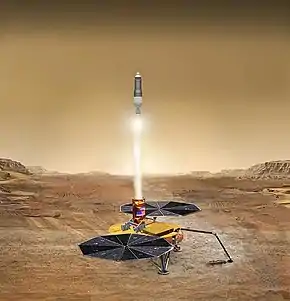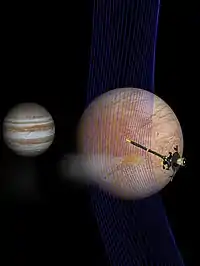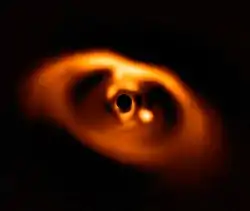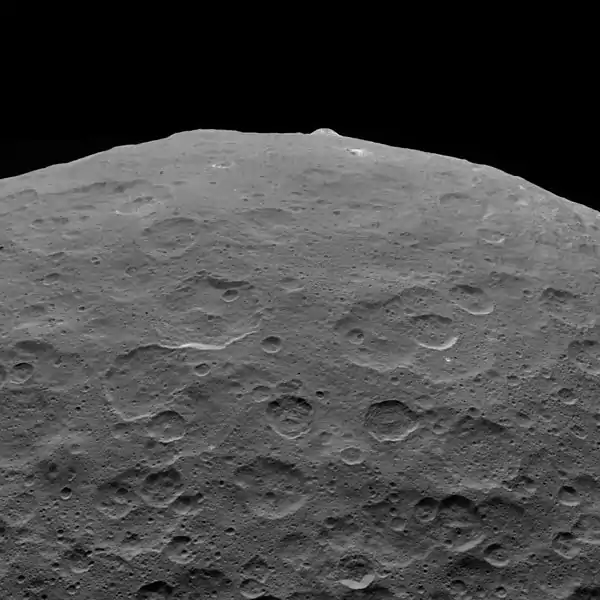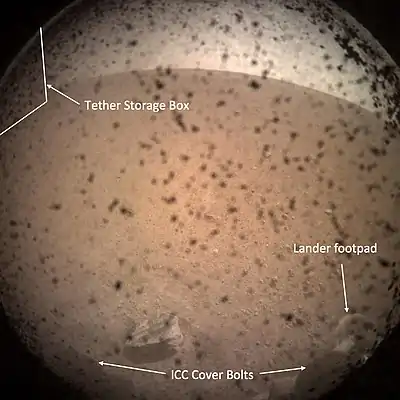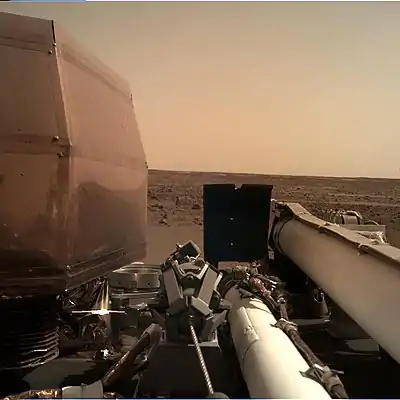2018 in science
Events
January
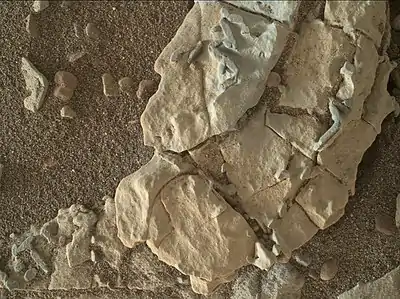
5 January: Curious rock shapes (biological or geological?) found on Mars by the Curiosity rover.[1][2]
- 1 January – Researchers at Harvard, writing in Nature Nanotechnology, report the first single lens that can focus all colours of the rainbow in the same spot and in high resolution, previously only achievable with multiple lenses.[3][4]
- 2 January – Physicists at Cornell University report the creation of "muscle" for shape-changing, cell-sized robots.[5][6]
- 3 January
- Computer researchers report discovering two major security vulnerabilities, named "Meltdown" and "Spectre," in the microprocessors inside almost all computers in the world.[7][8][9]
- Scientists in Rome unveil the first bionic hand with a sense of touch that can be worn outside a laboratory.[10]
- 4 January – MIT researchers devise a new method to create stronger and more resilient nanofibers.[11][12]
- 5 January – Researchers report images (including image-1) taken by the Curiosity rover on Mars showing curious rock shapes that may require further study in order to help better determine whether the shapes are biological or geological.[1][2] Later, an astrobiologist made a similar claim based on a different image (image-2) taken by the Curiosity rover.[13][14]
- 8 January – The National Oceanic and Atmospheric Administration (NOAA) reports that 2017 was the costliest year on record for climate and weather-related disasters in the United States.[15][16]
- 9 January
- A pattern in exoplanets is discovered by a team of multinational researchers led by the Université de Montréal: Planets orbiting the same star tend to have similar sizes and regular spacings. This could imply that most planetary systems form differently from the Solar System.[17]
- Analysis of the stone Hypatia shows it has a different origin than the planets and known asteroids. Parts of it could be older than the solar system.[18]
- A new study by researchers at Stanford University indicates the genetic engineering method known as CRISPR may trigger an immune response in humans, thus rendering it potentially ineffective in them.[19][20]
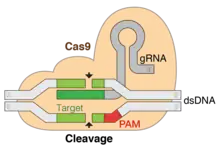
9 January: A potentially major setback for CRISPR is reported, as it is shown to trigger an immune response in many humans.
- 10 January – Researchers at Imperial College London and King's College London publish a paper in the journal Scientific Reports about the development of a new 3D bioprinting technique, which allows the more accurate printing of soft tissue organs, such as lungs.[21][22]
- 11 January
- In a study published in the journal Cell, University of Pennsylvania researchers show a method through which the human innate immune system may possibly be trained to more efficiently respond to diseases and infections.[23]
- A NASA experiment, Station Explorer for X-ray Timing and Navigation Technology (SEXTANT), shows how spacecraft may possibly determine their location by focusing on millisecond pulsars in space.[24][25]
- 15 January
- Artificial intelligence programs developed by Microsoft and Alibaba achieve better average performance on a Stanford University reading and comprehension test than human beings.[26][27][28]
- University of Washington scientists publish a report in the journal Nature Chemistry of the development of a new form of biomaterial based delivery system for therapeutic drugs, which only release their cargo under certain physiological conditions, thereby potentially reducing drug side-effects in patients.[29]
- University of Pennsylvania announces in the United States National Library of Medicine human clinical trials, that will encompass the use of CRISPR technology to modify the T cells of patients with multiple myeloma, sarcoma and melanoma cancers, to allow the cells to more effectively combat the cancers, the first of their kind trials in the US.[30][31]
- 17 January – Engineers at the University of Texas at Austin, in collaboration with Peking University scientists, announce the creation of a memory storage device only one atomic layer thick; a so-called 'atomristor'.[32]
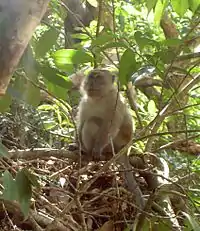
24 January: Creation, using nuclear DNA transfer, for the first time, of clones of a primate (specifically, crab-eating macaque monkeys similar to the one in the picture) reported.[33][34]
- 18 January
- NASA and NOAA report that 2017 was the hottest year on record globally without an El Niño, and among the top three hottest years overall.[35][36]
- Researchers report developing a blood test (or liquid biopsy) that can detect eight common cancer tumors early. The new test, based on cancer-related DNA and proteins found in the blood, produced 70% positive results in the tumor-types studied in 1005 patients.[37][38]
- Sharks are shown to move and feed across the world's oceans in characteristic ways as demonstrated by a global-scale study of stable isotopes in shark tissues led by the University of Southampton and published in the journal Nature Ecology and Evolution.[39]
- According to a new report published by the US National Science Foundation (NSF), the US is facing increasing competition in scientific endeavours from China, with the latter now publishing more annual scientific papers, but the US still leads in research and development (R&D) and venture capital (VC).[40][41]
- Medical researchers at the Gladstone Institutes discover a method of turning skin cells into stem cells, with the use of CRISPR.[42][43]
- 19 January – Researchers at the Technical University of Munich report a new propulsion method for molecular machines, which enables them to move 100,000 times faster than biochemical processes used to date.[44]
- 22 January
- 24 January – Scientists in China report in the journal Cell the creation of two monkey clones, named Zhong Zhong and Hua Hua, using the complex DNA transfer method that produced Dolly the sheep, for the first time.[33][34][50][51]
- 25 January
- Researchers report evidence that modern humans migrated from Africa at least as early as 194,000 years ago, somewhat consistent with recent genetic studies, and much earlier than previously thought.[52][53]
- Scientists working for Calico, a company owned by Alphabet, publish a paper in the journal eLife which presents possible evidence that Heterocephalus glaber (naked mole-rat) do not face increased mortality risk due to aging.[54][55][56]
- 29 January – Scientists report, for the first time, that 800 million viruses, mainly of marine origin, are deposited daily from the Earth's atmosphere onto every square meter of the planet's surface, as the result of a global atmospheric stream of viruses, circulating above the weather system, but below the altitude of usual airline travel, distributing viruses around the planet.[57][58]
February
.jpg.webp)
6 February: Successful launch of the Falcon Heavy, the most powerful rocket since the Space Shuttle program.[59]
- 2 February – A study published in the journal Science by researchers from the United States Geological Survey and the University of California, Santa Cruz reports the severe degradation of the health of polar bears in the Arctic, due to the effects of climate change.[60]
- 5 February
- Researchers find additional evidence for an exotic form of water, called superionic water, which is not found naturally on Earth, but could be common on the planets Uranus and Neptune.[61][62]
- Astronomers report evidence, for the first time, that extragalactic exoplanets, much more distant than the exoplanets found within the local Milky Way galaxy, may exist.[63][64]
- 6 February
- SpaceX successfully conducts its maiden flight of its most powerful rocket to date, and the most powerful rocket since the Space Shuttle program, the Falcon Heavy, from LC-39A at Kennedy Space Center.[59]
- The National Snow and Ice Data Center (NSIDC) reports that global sea ice extent has fallen to a new record low.[65]
- 8 February – Astronomers report the first confirmed findings from the Zwicky Transient Facility (ZTF) project, with the discovery of 2018 CL, a small near-Earth asteroid.[66][67]
- 9 February – Human eggs are grown in the laboratory for the first time, by researchers at the University of Edinburgh.[68][69]
- 13 February – Scientists at Rockefeller University, writing in the journal Nature Microbiology, describe how compounds in soil known as malacidins can overcome antibiotic resistance in mice with MRSA.[70]

14 February: Researchers found that blocking the enzyme beta-secretase (BACE1) in mice reduces formation of plaques responsible for Alzheimer's disease.[71][72]
- 14 February
- By studying the orbits of high-speed stars, researchers in Australia calculate that the Andromeda Galaxy has only one-third as much dark matter as previously thought, making it similar in mass to the Milky Way.[73]
- A study published by the Journal of Experimental Medicine shows that blocking the enzyme beta-secretase (BACE1) in mice can substantially reduce the formation of plaques responsible for Alzheimer's disease.[71][72]
- 16 February – Scientists report, for the first time, the discovery of a new form of light, which may involve polaritons, that could be useful in the development of quantum computers.[74][75]
- 19 February – Scientists identify traces of the genes of the indigenous Taíno people in modern-day Puerto Ricans, indicating that the ethnic group was not extinct as previously believed.[76]
- 21 February – Medical researchers report that e-cigarettes contain chemicals known to cause cancer and brain damage; as well as, contain potentially dangerous (even potentially toxic) levels of metals, including arsenic, chromium, lead, manganese and nickel.[77][78][79][80]
- 28 February – Astronomers report, for the first time, a signal of the reionization epoch, an indirect detection of light from the earliest stars formed – about 180 million years after the Big Bang.[81][82]
March
- 5 March
- Researchers at MIT and Harvard report in the journal Nature of discovering the phenomenon of graphene acting as a superconductor, when its atoms are re-arranged in a specific manner.[83][84][85]
- Google announces the creation of "Bristlecone", the world's most advanced quantum computer chip, featuring 72 qubits.[86][87]
- 8 March – Scientists report the first detection of natural ice VII on Earth, previously it was only produced artificially. It may be common on the moons Enceladus, Europa and Titan.[88][89]
- 9 March – NASA medical researchers report that human spaceflight may alter gene expression in astronauts, based on twin studies where one astronaut twin, Scott Kelly, spent nearly one year in space while the other, Mark Kelly, remained on Earth.[90][91][92]
- 13 March – Scientists report that Archaeopteryx, a prehistoric feathered dinosaur, was likely capable of flight, but in a manner substantially different from that of modern birds.[93][94]
- 15 March
- Intel reports that it will redesign its CPU processors (performance losses to be determined) to help protect against the Meltdown and Spectre security vulnerabilities (especially, Meltdown and Spectre-V2, but not Spectre-V1), and expects to release the newly redesigned processors later in 2018.[95][96][97][98]
- Researchers at the Gladstone Institutes report a new cellular therapy in the journal Neuron which shows promise in combating the effects of Alzheimer's disease.[99][100]
- 19 March – Uber suspends all of its self-driving cars worldwide after a woman is killed by one of the vehicles in Arizona. This is the first recorded fatality using a fully automated version of the technology.[101]
- 22 March – Scientists at Harvard Medical School identify a key mechanism behind vascular aging and muscle decline in mice. Their study shows that treating the animals with a chemical compound called NMN enhances blood vessel growth and reduces cell death, boosting their stamina and endurance.[102]
- 26 March
- A study in Geophysical Research Letters concludes that West Greenland's ice sheet is melting at its fastest rate in centuries.[103]
- The world's first total transplant of a penis and scrotum is performed by surgeons at Johns Hopkins University in Baltimore, Maryland, operating on a soldier who was wounded in Afghanistan.[104]
April

10 April: Centuries' worth of rare-earth metals reported near the island of Minami-Tori-shima (pictured).
- 2 April
- The inoperative Tiangong-1 space lab comes down over the South Pacific Ocean, northwest of Tahiti.[105][106]
- Astronomers report the detection of the most distant individual star (actually, a blue supergiant), named Icarus (formally, MACS J1149 Lensed Star 1), at 9 billion light-years (light-travel distance) away from Earth.[107][108]
- 5 April – Odilorhabdins, a novel class of naturally-produced antibiotics, is formally described.[109]
- 10 April – Researchers in Japan report finding centuries' worth of rare-earth metals in deep sea mud, located near Minami-Tori-shima in the northwest Pacific.[110][111][112]
- 11 April – Two studies, both published in Nature,[113][114] find that the warm Atlantic Gulf Stream is at its weakest for at least 1,600 years.[115]
- 17 April – Engineers at MIT develop a new more efficient method of producing long strips of graphene.[116][117]
- 18 April
- NASA's Transiting Exoplanet Survey Satellite (TESS) is launched.[118][119]
- Nanyang Technological University demonstrates a robot that can autonomously assemble an IKEA chair without interruption.[120][121]
- 19 April – The results of a new gene therapy trial of 22 patients with the blood disorder beta thalassemia, published in the New England Journal of Medicine, indicates 15 of the patients being cured entirely while 7 requiring fewer annual blood transfusions.[125][126][127][128]
- 25 April
- 26 April
- Scientists report that a letter of intent was signed by NASA and ESA which may provide a basis for sample return missions to other planets, including Mars sample return missions, with the purpose of better studying the possible existence of past or present extraterrestrial primitive life forms, including microorganisms.[122][123][124]
- Scientists identify 44 gene variants linked to increased risk for depression.[132][133][134]
- The Belle II experiment starts taking data to study B mesons.[135]
- 27 April – Stephen Hawking's final paper – A smooth exit from eternal inflation? – is published in the Journal of High Energy Physics.[136]
- 30 April – Researchers report identifying 6,331 groups of genes that are common to all living animals, and which may have arisen from a single common ancestor that lived 650 million years ago in the Precambrian.[137][138]
May
- 1 May – The Genome Project-Write announces a new 10 year initiative to attempt to make human cells immune to viral infections.[139][140][141]
- 2 May – Scientists discover that Helium is present in the exoplanet WASP-107b.[145]
- 5 May – The InSight spacecraft, designed to study the interior and subsurface of the planet Mars, successfully launches at 11:05 UTC, with an expected arrival on 26 November 2018.[146][147]
- 9 May – Scientists report that the curious physical phenomenon of quantum entanglement is even more supported based on recent rigorous Bell test experimentations.[148][149]
- 10 May – NASA's Carbon Monitoring System (CMS) is cancelled by the Trump administration.[150]
- 11 May – NASA approves the Mars Helicopter for the Mars 2020 mission.[142][143][144]
- 14 May
- Astronomers publish supporting evidence of water plume activity on Europa, moon of the planet Jupiter, based on an updated critical analysis of data obtained from the Galileo space probe, which orbited Jupiter between 1995 and 2003. Such plume activity, similar to that found on Saturn's moon Enceladus, could help researchers search for life from the subsurface European ocean without having to land on the moon.[151][152][153][154]
- Anthropologists provide evidence that the brain of Homo naledi, an extinct hominid which is thought to have lived between 226,000 and 335,000 years ago, was small, but nonetheless complex, sharing structural similarities with the modern human brain.[155][156]
- 17 May – Scientists warn that banned CFC-11 gas emissions are originating from an unknown source somewhere in East Asia, with potential to damage the ozone layer.[157]
- 22 May
- Scientists report another CPU security vulnerability, related to the Spectre and Meltdown vulnerabilities, called Speculative Store Bypass (SSB), and affecting the ARM, AMD and Intel families of cpu processors.[158][159][160]
- Scientists from Purdue University and the Chinese Academy of Sciences report the use of CRISPR/Cas9 to develop a variety of rice producing 25-31% more grain than traditional breeding methods.[161]
- Significant asteroid data arising from the Wide-field Infrared Survey Explorer and NEOWISE missions is questioned.[162][163]
- 23 May – Paleontologists report finding the skull of a new species of haramiyida (a long lived lineage of mammaliaform cynodonts), called Cifelliodon wahkarmooshuh, underneath the fossilized foot of a large dinosaur that lived 130 million years ago in North America.[164][165]
- 24 May
- Based largely on government data, including data from NASA, FEMA and others, The New York Times reports an exhaustive overview of recurrent natural disasters in the United States since 1900.[166]
- Astronomers claim that the dwarf planet Pluto may have been formed as a result of the agglomeration of numerous comets and related Kuiper belt objects.[167][168]
- Researchers at the University of Leeds report that climate change could increase arable land in boreal regions by 44% by the year 2100, while having a negative impact everywhere else.[169]
- 30 May
- The first 3D printed human corneas are created at Newcastle University.[170]
- The FDA approves the first artificial iris.[171]
- Physicists of the MiniBooNE experiment report a stronger neutrino oscillation signal than expected, a possible hint of sterile neutrinos, an elusive particle that may pass through matter without any interaction whatsoever.[172][173]
June
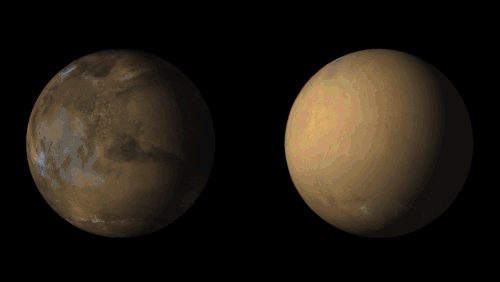
1 June: Mars dust storm (before/after) detected that may affect the survivability of the Opportunity rover.[174][175]
- 1 June – NASA scientists detect signs of a dust storm on the planet Mars which may affect the survivability of the solar-powered Opportunity rover since the dust may block the sunlight (see image) needed to operate; as of 12 June, the storm spanned an area about the size of North America and Russia combined (about a quarter of the planet); as of 13 June, Opportunity was reported to be experiencing serious communication problem(s) due to the dust storm;[176] a NASA teleconference about the dust storm was presented on 13 June 2018 at 01:30 pm/et/usa and is available for replay.[174][175][177][178] On 20 June, NASA reported that the dust storm had grown to completely cover the entire planet.[179][180]
- 4 June – Direct coupling of the Higgs boson with the top quark is observed for the first time by the ATLAS experiment[181] and the CMS experiment[182] at CERN.
- 5 June – Researchers at Case Western Reserve University School of Medicine synthesise the first artificial human prion.[183]
- 6 June
- Footprints in the Yangtze Gorges area of South China, dating back 546 million years, are reported to be the earliest known record of an animal with legs.[184]
- The spacecraft Dawn assumes a final (and much closer) orbit around the dwarf planet Ceres: as close as 35 km (22 mi) and as far away as 4,000 km (2,500 mi) (see images).[185][186]
- 7 June – NASA announces that the Curiosity rover has detected a cyclical seasonal variation in atmospheric methane (see image) on the planet Mars, as well as the presence of kerogen and other complex organic compounds.[187][188][189][190][191][192][193][194]
- 8 June – The U.S. Department of Energy's Oak Ridge National Laboratory unveils Summit as the world's most powerful supercomputer, with a peak performance of 200,000 trillion calculations per second, or 200 petaflops.[195][196]
- 11 June – KATRIN, an experiment designed to measure the absolute mass of neutrinos, starts data-taking.[197]
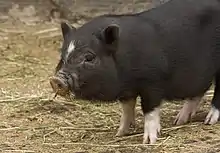
20 June: Gene-edited pigs are made resistant to porcine reproductive and respiratory syndrome, one of the world's most costly animal diseases.[198]
- 14–15 June – The Japanese Hayabusa2 probe returns images of the asteroid 162173 Ryugu from a distance of 650–700 km.[199] It enters orbit on 27 June.
- 16 June – Astronomers detect AT2018cow (ATLAS name: ATLAS18qqn), a powerful astronomical explosion, 10-100 times brighter than a normal supernova,[200] that may be a cataclysmic variable star (CV), gamma-ray burst (GRB), gravitational wave (GW), supernova (SN) or something else.[201][202][203] By 22 June 2018, this astronomical event had generated a significant interest among astronomers throughout the world,[204][202] and may be, as of 22 June 2018, considered a supernova, tentatively named Supernova 2018cow (SN 2018cow).[205][206] However, the true identity of AT2018cow remains unclear, according to astronomers.[202][207]
- 18 June – MIT publishes details of "VoxelMorph", a new machine-learning algorithm, which is over 1,000 times faster at registering brain scans and other 3-D images.[208]
- 20 June – Scientists at the University of Edinburgh report that gene-edited pigs have been made resistant to porcine reproductive and respiratory syndrome, one of the world's most costly animal diseases.[198]
- 21 June – The US National Science and Technology Council warns that America is unprepared for an asteroid impact event, and has developed and released the "National Near-Earth Object Preparedness Strategy Action Plan" to better prepare.[209][210][162][163][211]
- 26 June – Researchers at the University of California, Los Angeles, develop synthetic T cells that mimic the form and function of real human versions.[212]
- 27 June
- Astronomers report that ʻOumuamua, an object from interstellar space passing through the solar system, is a mildly active comet, and not an asteroid, as previously thought. This was determined by measuring a non-gravitational boost to ʻOumuamua's acceleration, consistent with comet outgassing. (image) (animation)[213][214][215]
- Astronomers report the detection of complex macromolecular organics on Enceladus, moon of the planet Saturn.[216][217]
July
- 2 July
- 10 July – Researchers at the University of Michigan show that increased atmospheric CO2 reduces the medicinal properties of milkweed plants that protect monarch butterflies from disease.[222]
- 11 July – Scientists report the discovery in China of the oldest stone tools outside of Africa, estimated at 2.12 million years old.[223]
- 12 July
- The IceCube Neutrino Observatory announces that they have traced a neutrino that hit their Antarctica-based research station in September 2017 back to its point of origin in a blazar 3.7 billion light-years away. This is the first time that a neutrino detector has been used to locate an object in space.[224][225][226]
- Using NASA's Hubble and ESA's Gaia, astronomers make the most precise measurements to date of the universe's expansion rate – a figure of 73.5 km (45.6 miles) per second per megaparsec – reducing the uncertainty to just 2.2 percent.[227]
- 16 July – A study by the University of Wisconsin-Madison concludes that thousands of miles of buried Internet infrastructure could be damaged or destroyed by rising sea levels within 15 years.[228]
- 17 July – Scientists led by Scott S. Sheppard report the discovery of 12 new moons of Jupiter, taking its total number to 79. This includes an "oddball", Valetudo (originally known as S/2016 J 2; Roman-numeral designation Jupiter LXII), that is predicted to eventually collide with a neighbouring moon.[229][230]
- 19 July – A complete fruit fly connectome is mapped at nanoscale resolution for the first time, using two high-speed electron microscopes on 7,000 brain slices and 21 million images.[231]
- 20 July
- Researchers report that the largest single source of dust on the planet Mars comes from the Medusae Fossae Formation.[232]
- Scientists at the University of Alabama at Birmingham announce the reversal of aging-associated skin wrinkles and hair loss in a mouse model.[233]
- 23 July
- A study published in Nature Climate Change finds that the death toll from suicide in the United States and Mexico has risen between 0.7 and 2.1 percent with each degree (Celsius) of increased monthly average temperature. By 2050, this could lead to an additional 21,000 suicides.[234]
- Scientists at the University of Alberta report a new technique, based on quickly removing or replacing single hydrogen atoms, which can provide a thousand-fold increase in solid-state memory density.[235][236]
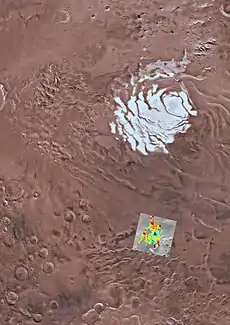
- 25 July
- Scientists report the discovery, based on MARSIS radar studies, of a subglacial lake on Mars, 1.5 km (0.93 mi) below the southern polar ice cap (see image), and extending sideways about 20 km (12 mi), the first known stable body of water on the planet.[237][238][239][240]
- NASA's Transiting Exoplanet Survey Satellite (TESS) begins science operations.[241]
- Researchers in Brazil describe a new two-dimensional material called "hematene", derived from hematite, with application as a photocatalyst.[242]
- 27 July – The longest total lunar eclipse of the 21st century occurs.[243]
- 28 July – Artificial intelligence is used to demonstrate a link between personality type and eye movements.[244]
- 30 July
- Using high-resolution satellite images, researchers from the Chizé Centre for Biological Studies report an 88% reduction in the world's biggest colony of king penguins, found on Île aux Cochons in the subantarctic Crozet Archipelago.[245]
- A study by NASA's Goddard Space Flight Center concludes that terraforming of Mars is physically impossible with present-day technology.[246]
- 31 July – Astronomers report the detection of an extremely strong magnetic field and aurora around a brown dwarf, which may possibly be a rogue planet, designated SIMP J01365663+0933473.[247]
August
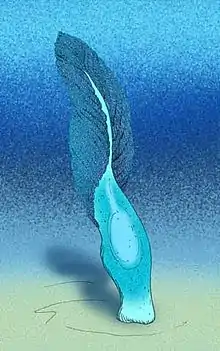
8 August: Stromatoveris psygmoglena, which dominated oceans a half billion years ago, found to be a member of Animalia.[248]
- 1 August
- Earth Overshoot Day 2018 is reached.
- Astronomers report that FRB 180725A is the first detection of a Fast radio burst (FRB) under 700 MHz – as low as 580 MHz.[249][250]
- Lab-grown lungs are successfully transplanted into pigs for the first time.[251]
- 7 August – NASA researchers report confirmation by the New Horizons spacecraft of a "hydrogen wall" at the outer edges of the Solar System that was first detected in 1992 by the two Voyager spacecraft.[252][253]
- 8 August
- Biologists report that Stromatoveris psygmoglena, an Ediacaran organism that dominated oceans half a billion years ago, was a member of Animalia, based on phylogenetic analysis.[248][254]
- Computer researchers report that Artificial Intelligence (AI) programs have found thousands of prominent scientists overlooked by Wikipedia editors.[255]
- 9 August – Researchers in China establish a new record for organic photovoltaic cells, boosting their maximum efficiency from 15 to 17.3 percent.[256][257]
- 12 August – A Delta IV Heavy launches the Parker Solar Probe to study the Sun and the solar wind.[258][259][260]
- 13 August – Astronomers at the Chandra X-ray Observatory report that the X-ray afterglow from a one-year-old neutron star merger—associated with GW170817 (gravitational wave), GRB 170817A (gamma ray burst) and AT 2017gfo (visible transient)—is fading at an increasingly rapid rate at 358.6 days after the event.[261]
- 14 August
- Computer researchers report discovering another security vulnerability, named "Foreshadow", that may affect Intel processors inside personal computers and in third party clouds.[262][263][264]
- Groundbreaking begins on the Giant Magellan Telescope in Chile. It is expected to be operational by 2024.[265]
- 15 August – Astronomers report the detection of iron and titanium vapours in the atmosphere of an 'ultra-hot Jupiter' in close orbit around the large B-type star, KELT-9.[266]

16 August: First complete map of the wheat genome.
- 16 August
- Scientists announce the transformation of gaseous deuterium into a liquid metallic form. This may help researchers better understand giant gas planets, such as Jupiter, Saturn and related exoplanets, since such planets are thought to contain a lot of liquid metallic hydrogen, which may be responsible for their observed powerful magnetic fields.[267][268]
- The wheat genome is fully sequenced after a 13-year effort.[269]
- Scientists at Sandia National Laboratories reveal a platinum-gold alloy believed to be the most wear-resistant metal in the world, 100 times more durable than high-strength steel.[270]
- 18 August – Research presented at the Goldschmidt conference in Boston concludes that water is likely to be a common feature of exoplanets between two and four times the size of Earth, with implications for the search of life in our Galaxy.[271]
- 20 August
- Scientists report that life, based on genetic and fossil evidences, may have begun on Earth nearly 4.5 billion years ago, much earlier than thought before.[272][273]
- Researchers report that the skyglow of STEVE ("Strong Thermal Emission Velocity Enhancement"), an atmospheric optical phenomenon appearing as a purple and green light ribbon in the sky, and not an aurora, is not associated with particle precipitation (electrons or ions) and, as a result, could be generated in the ionosphere.[274]
- 21 August – Scientists announce the first direct evidence for exposed water-ice on the Moon's surface, which is found in permanently shaded regions.[275]
- 22 August
- Scientists report evidence of a 13-year-old hominin female, nicknamed Denny, estimated to have lived 90,000 years ago, and who was determined to be half Neanderthal and half Denisovan, based on genetic analysis of a bone fragment discovered in Denisova Cave; the first time an ancient individual was discovered whose parents belonged to distinct human groups.[276][277][278]
- Researchers report evidence of rapid shifts (in geological-time terms), nearly 30 times faster than known previously, of geomagnetic reversals, where the north magnetic pole of Earth becomes the south magnetic pole and vice versa, including a chronozone that lasted only 200 years, much shorter than any other such reversal found earlier.[279]
- 28 August – Physicists officially report, for the first time, observing the Higgs boson decay into a pair of bottom quarks, an interaction that is primarily responsible for the "natural width" (range of masses with which a particle is observed) of the boson.[280]
- 30 August – Researchers from the Chinese University of Hong Kong report a new way of controlling nanobots, using swarm behaviours to do complex tasks in minimally invasive surgeries.[281][282]
September
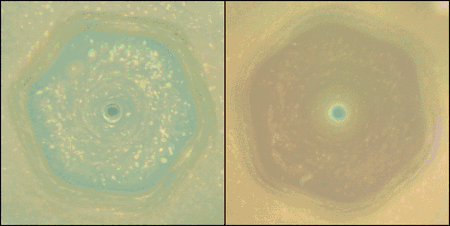
3 September: Hexagon (in 2013 & 2017) at the north pole on the planet Saturn may be a jet stream of atmospheric gases moving at 320 km/h (200 mph) and 300 km (190 mi) high.[283][284]
- 3 September – Astronomers present evidence that the 32,000 km (20,000 mi) wide hexagon at the north pole of the planet Saturn (possibly a jet stream of atmospheric gases moving at 320 km/h (200 mph)) may be 300 km (190 mi) high, well into the stratosphere, at least during the northern spring and summer, rather than lower in the troposphere as thought earlier.[283][284]
- 6 September – A study by the University of Illinois at Urbana–Champaign finds that large-scale solar panels and wind turbines in the Sahara desert would have a major impact on rainfall, vegetation and temperatures – potentially greening the region.[285][286]
- 7 September
- Researchers at the National Geospatial-Intelligence Agency release a high resolution terrain map (detail down to the size of a car, and less in some areas) of Antarctica, named the "Reference Elevation Model of Antarctica" (REMA).[287]
- A group of Japanese and American scientists publish a research paper which concludes that "space weathering" on the surface of Phobos, in tandem with its eccentric orbit, has caused its surface to be divided into two distinct geologic units, known as the red and blue units.[288]
- 9 September – Astronomers report detecting another 72 Fast Radio Bursts (FRBs), using artificial intelligence, from FRB 121102 that had been missed earlier, resulting in about 300 total FRBs from this object. FRB 121102 is the only known repeating fast radio source which is very unusual since all other currently known FRBs (very powerful and extremely short-lived astronomical objects) have not been found to repeat, occurring one time only.[289][290][291]
- 10 September
- NASA wins an Emmy Award for Outstanding Original Interactive Program for its presentation of the Cassini mission's Grand Finale at Saturn.[294]
- The Massachusetts Institute of Technology (MIT) announces "Dense Object Nets" (DON), a new system that allows robots to pick up any object after visually inspecting it.[295]
- An international team of researchers predict the entire set of beneficial 3-D distortions for controlling edge localised modes (ELMs) in tokamak plasma, without creating more problems.[296]
- 12 September – Scientists report the discovery of the earliest known drawing by Homo sapiens, which is estimated to be 73,000 years old, much earlier than the 43,000 years old artifacts understood to be the earliest known modern human drawings found previously.[297]
- 15 September – NASA launches ICESat-2, the agency's most technologically advanced ice-monitoring spacecraft to date.[298]
- 16 September
- Astronomers report determining that the warm-hot intergalactic medium (or WHIM) may be where the missing matter (not dark matter) has been hiding in the universe.[299]
- Medical researchers conclude, based on a 19,114 person study conducted over five years, that use of low-dose aspirin by older healthy people may not be beneficial and, in some case, may be harmful.[292][293]
- 17 September – NASA releases the first light image (see image) (taken on 7 August 2018) by the Transiting Exoplanet Survey Satellite (TESS), a space telescope designed to search for exoplanets in an area 400 times larger than that covered by the Kepler mission.[300][301][302]
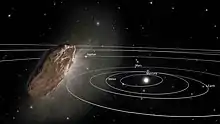
24 September: Astronomers describe several possible star systems from where 'Oumuamua, an interstellar object passing through the Solar System, may have begun its journey.[303]
- 20 September
- Researchers at Cincinnati Children's Hospital Medical Center report the first human oesophageal tissue grown entirely from pluripotent stem cells.[304]
- Researchers identify human skeletal stem cells for the first time.[305]
- Scientists discover molecules of fat in an ancient fossil to reveal the earliest confirmed animal in the geological record that lived on Earth 558 million years ago.[306]
- A paper in the Cryosphere journal, from the European Geosciences Union, suggests that building walls on the seafloor could halt the slide of undersea glaciers, which are melting due to warmer ocean temperatures.[307]
- Using data from the European Space Agency's X-ray observatory XMM-Newton, astronomers report the first detection of matter falling into a black hole at 30% of the speed of light, located in the centre of the billion-light year distant galaxy PG211+143.[308]
- 21 September – The Japanese Hayabusa2 probe deploys two landers on the surface of the large asteroid Ryugu.[309]
- 24 September
- Data from the Cassini–Huygens spacecraft, which explored Saturn and its moons between 2004 and 2017, reveals what appear to be three giant dust storms (see image), for the first time, in the equatorial regions of the moon Titan between the years 2009–2010.[310][311]
- Astronomers describe several possible home star systems from which the interstellar object 'Oumuamua, found passing through the Solar System in October 2017, may have begun its interstellar journey.[303] Studies suggest that the interstellar object is neither an asteroid nor a comet.[312][313]

25 September: Vorombe titan (similar to purple above; maroon, an ostrich; all others non-avian theropod dinosaurs), an extinct elephant bird, determined to be the largest bird known to have existed.[314][315][316]
- 25 September
- Medical researchers report that Omega-3 fatty acids may significantly reduce the risk of cardiovascular events in some patients with a history of heart disease or type 2 diabetes.[317]
- Scientists determine that Vorombe titan, an extinct elephant bird from the island of Madagascar which reached weights of 800 kg (1,800 lb) and heights of 3 m (9.8 ft) tall, is the largest bird known to have existed.[314][315][316]
- 26 September – Researchers provide evidence that phosphorus compounds, key components for life, are made in interstellar space and distributed throughout outer space, including the early Earth.[318]
- 27 September – A study in the journal Science concludes that polychlorinated biphenyls (PCBs) could halve killer whale populations in the most heavily contaminated areas within 30–50 years.[319]
October
- 1 October
- James P. Allison from the United States and Tasuku Honjo from Japan win the Nobel Prize in Physiology or Medicine "for their discovery of cancer therapy by inhibition of negative immune regulation."[320]
- NASA-funded researchers find that lengthy journeys into outer space, including travel to the planet Mars, may substantially damage the gastrointestinal tissues of astronauts. The studies support earlier work that found such journeys could significantly damage the brains of astronauts, and age them prematurely.[321] However, unlike the conditions in space, the study admitted the full radiation doses over short periods.[322]
- Astronomers announce the discovery of 2015 TG387 (also known as "The Goblin"), a trans-Neptunian object and sednoid in the outermost part of the Solar System, which may help explain some apparent effects of a hypothetical planet named Planet Nine (or Planet X).[323][324]
.tif.jpg.webp)
3 October: Evidence presented for first known exomoon, which may be orbiting exoplanet Kepler-1625b.[325][326]
- 2 October
- Arthur Ashkin from the United States, Gérard Mourou from France and Donna Strickland from Canada win the Nobel Prize in Physics "for groundbreaking inventions in the field of laser physics".[327]
- Astronomers using data from the Gaia mission report the discovery of rogue, high-velocity stars hurtling towards the Milky Way, possibly originating from another galaxy.[328]
- 3 October
- Frances H. Arnold from the United States, George P. Smith from the United States and Gregory P. Winter from the United Kingdom win the Nobel Prize in Chemistry for their work in evolutionary science.[329]
- Astronomers publish details of a candidate exomoon, Kepler-1625b I, suggesting it has a mass and radius similar to Neptune, and orbits the exoplanet Kepler-1625b.[325][326][330][331]
- 4 October – Researchers at McMaster University announce the development of a new technology, called a Planet Simulator, to help study the origin of life on planet Earth and beyond.[332][333][334][335]
- 5 October – The Hubble Space Telescope is hit by a mechanical failure as it loses one of the gyroscopes needed for pointing the spacecraft. It is placed into "safe" mode while scientists attempt to fix the problem.[336]
- 8 October
- The IPCC releases its Special Report on Global Warming of 1.5ºC, warning that "rapid, far-reaching and unprecedented changes in all aspects of society" are needed to keep global warming below 1.5 °C.[337][338][339]
- Researchers report low-temperature chemical pathways from simple organic compounds to complex polycyclic aromatic hydrocarbon (PAH) chemicals. Such chemical pathways may help explain the presence of PAHs in the low-temperature atmosphere of Titan, a moon of the planet Saturn, and may be significant pathways, in terms of the PAH world hypothesis, in producing precursors to biochemicals related to life as we know it.[340][341]
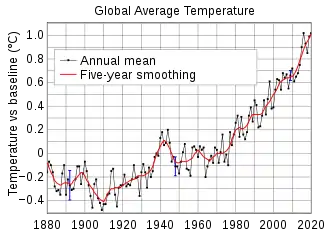
8 October: IPCC releases Special Report on Global Warming, noting the need to keep global warming below 1.5°C.[337][338][339]
- 10 October
- Astronomers report 19 more new non-repeating FRB bursts detected by the Australian Square Kilometre Array Pathfinder (ASKAP).[342][343]
- Physicists report producing quantum entanglement using living organisms, particularly between living bacteria and quantized light.[344][345]
- 11 October
- Physicists report that quantum behavior can be explained with classical physics for a single particle, but not for multiple particles as in quantum entanglement and related nonlocality phenomena ("spooky action at a distance" ["gruselige Action in einiger Entfernung" (German)],[346] according to Albert Einstein).[347][348][lower-alpha 1]
- Harvard astronomers present an analytical model that suggests matter—and potentially dormant spores—can be exchanged across the vast distances between galaxies, a process termed 'galactic panspermia', and not be restricted to the limited scale of solar systems.[350][351]
- The world's fastest camera, able to capture 10 trillion frames per second, is announced by the Institut national de la recherche scientifique (INRS) in Quebec, Canada.[352]
- 15 October – A study by the Rensselaer Polytechnic Institute finds that insect populations in Puerto Rico have crashed since the 1970s, with some species witnessing a 60-fold decrease in numbers. The fall is attributed to a 2.0 °C rise in tropical forest temperatures.[353]
- 16 October
- The final published book by physicist Stephen Hawking, entitled Brief Answers to the Big Questions, is released.[354][355][356][357]
- A comprehensive analysis of demographic trends published in The Lancet predicts that all countries are likely to experience at least a slight increase in life expectancy by 2040. Spain is expected to overtake Japan as it rises from fourth to first place, with an average lifespan of 85.8 years.[358][359]
- Astronomers report that GRB 150101B, a gamma-ray burst event detected in 2015, may be directly related to the historic GW170817, a gravitational wave event detected in 2017, and associated with the merger of two neutron stars. The similarities between the two events, in terms of gamma ray, optical and x-ray emissions, as well as to the nature of the associated host galaxies, are "striking", suggesting the two separate events may both be the result of the merger of neutron stars, and both may be a kilonova (i.e., a luminous flash of radioactive light that produces elements like silver, gold, platinum and uranium), which may be more common in the universe than previously understood, according to the researchers.[360][361][362][363]
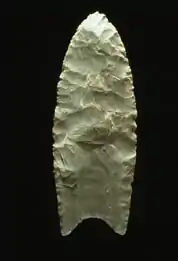
24 October: Oldest weapons, chert spear points, dated as early as 15,500 years ago, found in North America [note: similar, but more recent, clovis point pictured][364][365]
- 17 October
- Researchers report possible transgenerational epigenetic inheritance (i.e., transmission of information from one generation of an organism to the next that affects the traits of offspring without alteration of the primary structure of DNA) in the form of paternal transmission of epigenetic memory via of sperm chromosomes in the roundworm Caenorhabditis elegans, a laboratory test organism.[366][367]
- A study by Stanford University finds that the use of virtual reality can induce greater compassion in people than other forms of media.[368]
- 20 October – The joint ESA/JAXA BepiColombo probe is launched to the planet Mercury.
- 22 October
- A study by the University at Albany forecasts that Peru's Quelccaya ice cap will reach a state of irreversible retreat by the mid-2050s, if current warming trends continue.[369][370]
- Researchers at the University of Queensland recreated 450 million-year-old enzymes with thermostable proteins, which can withstand higher temperatures, and could be used to improve drugs and gene therapy.[371]
- 24 October – Scientists report discovering the oldest weapons found in North America, ancient spear points, dated to 13,500 – 15,500 years ago, made of chert, predating the clovis culture (typically dated to 13,000 years ago), in the state of Texas.[364][365]
- 26 October – Astronomers confirm the existence of dust cloud satellites, called Kordylewski clouds, in semi-stable regions (the L4 and L5 Lagrangian points of the Earth–Moon system) about 400,000 km (250,000 mi) above the planet Earth.[372][373][374]
- 30 October
- NASA announces that the Kepler space telescope, having run out of fuel, and after nine years of service and the discovery of over 2,600 exoplanets, has been officially retired, and will maintain its current, safe orbit, away from Earth.[375][376]
- Scientists announce the 3-D virtual reconstruction, for the first time, of a Neanderthal rib cage, which may help researchers better understand how this ancient human species moved and breathed.[377][378]
November
1 November: The Dawn spacecraft, that studied protoplanets, Ceres and Vesta, is retired after an 11 year mission – last views pictured.[379]
- 1 November
- The Earth BioGenome Project is launched, a 10-year global effort to sequence the genomes of all 1.5 million known animal, plant, protozoan and fungal species on Earth.[380][381]
- NASA announces the official retirement, due to the depletion of fuel, of the Dawn spacecraft mission, that lasted 11 years, and that studied two protoplanets, Vesta and Ceres. The spacecraft will remain in a relatively stable orbit around Ceres for at least the next 20 years, serving as a "monument" to the mission.[379][382]
- Russian scientists release a video recording of the Soyuz MS-10 manned spaceflight mission involving a Soyuz-FG rocket after launch on 11 October 2018 that, due to a faulty sensor, resulted in the destruction of the rocket. The crew, NASA astronaut Nick Hague and Russian cosmonaut Aleksey Ovchinin. escaped safely and successfully.[383]
- Astronomers from Harvard University suggest that the interstellar object 'Oumuamua may be an extraterrestrial solar sail from an alien civilization, in an effort to help explain the object's "peculiar acceleration".[384][385][386]
- 2 November
- Two independent teams of astronomers both conclude, based on numerous observations from other astronomers around the world, that the unusual AT2018cow event (also known as Supernova 2018cow, SN 2018cow, and "The Cow"), a very powerful astronomical explosion, 10 – 100 times brighter than a normal supernova detected on 16 June 2018, was "either a newly formed black hole in the process of accreting matter, or the frenetic rotation of a neutron star."[387][388][389][390]
- The world's largest neuromorphic supercomputer, the million-core 'SpiNNaker' machine, is switched on by the University of Manchester, England.[391]
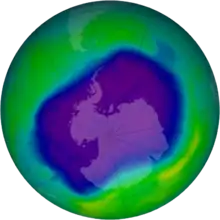
5 November: Polar ozone holes are healing faster than previously thought, and are expected to completely heal by 2060.[392][393]
- 4 November – Geologists present evidence, based on studies in Gale Crater by the Curiosity rover, that there was plenty of water on early Mars.[394][395]
- 5 November
- Astronomers report the discovery of one of the oldest stars, named 2MASS J18082002-5104378 B, in the universe, about 13.5 billion-years-old, possibly one of the first stars, a tiny ultra metal-poor (UMP) star made almost entirely of materials released from the Big Bang. The discovery of the star in the Milky Way galaxy suggests that the galaxy may be at least 3 billion years older than thought earlier.[396][397][398]
- A new assessment of the ozone hole, published by the UN, shows it to be recovering faster than previously thought. At projected rates, the Northern Hemisphere and mid-latitude ozone is expected to heal completely by the 2030s, followed by the Southern Hemisphere in the 2050s and polar regions by 2060.[392][393]
- Scientists report the discovery of the smallest known ape, Simiolus minutus, which weighed approximately eight pounds, and lived about 12.5 million years ago in Kenya in East Africa.[399][400]
- 7 November – Scientists report the discovery of the oldest known figurative art painting, over 40,000 (perhaps as old as 52,000) years old, of an unknown animal, in the cave of Lubang Jeriji Saléh on the Indonesian island of Borneo (see image).[401][402][403]
- 12 November – China's Institute of Plasma Physics announces that plasma in the Experimental Advanced Superconducting Tokamak (EAST) has reached 100 million degrees Celsius.
- 14 November – Astronomers report the discovery of GJ 699 b, a Super-Earth orbiting near the snow line of Barnard's Star, just six light years from Earth.[404][405][406][407]
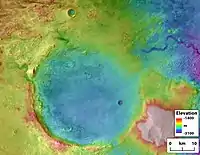
19 November: NASA chooses Jezero crater as the landing site of the Mars 2020 rover mission, to land on Mars in February 2021.[408]
- 16 November
- The 26th General Conference on Weights and Measures (CGPM) votes unanimously in favour of revised definitions of the SI base units,[409][410][411] which the International Committee for Weights and Measures (CIPM) had proposed earlier that year. The new definitions come into force on 20 May 2019.[412][413]
- Researchers at Japan's National Institute of Advanced Industrial Science and Technology (AIST) reveal a humanoid robot prototype, HRP-5P, intended to autonomously perform heavy labor or work in hazardous environments.[414]
- Astronomers conclude that the many grooves on Phobos, one of two moons orbiting Mars, were caused by boulders, ejected from the asteroid impact that created Stickney crater (which takes up a substantial portion of the moon's surface), that rolled around on the surface of the moon.[415][416]
- 19 November – NASA chooses Jezero crater on the planet Mars as the landing site for the Mars 2020 rover, which is to launch on 17 July 2020, and touch down on Mars on 18 February 2021.[408][417][418][419]
- 20 November
- Astronomers report the use of a new powerful method, NIRSpec in adaptive optics (AO) mode (NIRSPAO), to search for biosignatures on exoplanets.[420][421]
- The World Meteorological Organization (WMO) publishes its latest Greenhouse Gas Bulletin, showing record high concentrations of heat-trapping greenhouse gases, with levels of carbon dioxide (CO2) reaching 405.5 parts per million (ppm) in 2017, up from 403.3 ppm in 2016 and 400.1 ppm in 2015. The WMO reports that "there is no sign of a reversal in this trend, which is driving long-term climate change, sea level rise, ocean acidification and more extreme weather."[422][423]
- 22 November
- 35 genes that predispose people to chronic kidney disease are discovered by scientists at the University of Manchester.[424]
- Research published in Environmental Research Letters concludes that stratospheric aerosol injection to curb global warming is "technically possible" and would be "remarkably inexpensive" at $2 to 2.5 billion per year over the first 15 years.[425][426]
- 23 November
- Volume II of the Fourth National Climate Assessment (NCA4) is released by the U.S. government.[428][429][430][431]
- The Brazilian government reports that deforestation in the Amazon rainforest has reached its highest rate for a decade, with 7,900 km2 (3,050 sq miles) destroyed between August 2017 and July 2018, largely due to illegal logging.[432][433]
- Researchers report, after detecting the presence on the International Space Station (ISS) of five Enterobacter bugandensis bacterial strains, none pathogenic to humans, that microorganisms on ISS should be carefully monitored to continue assuring a medically healthy environment for astronauts.[434][435]
- 24 November – Scientists report that nearly all extant populations of animals, including humans, may be a result of a population expansion that began between one and two hundred thousand years ago, based on genetic mitochondrial DNA studies.[436][437][438][439]
- 25 November – Chinese scientists report the birth of twin human girls, Lulu and Nana, as the world's first genetically edited babies. The human genes were edited to resist HIV.[440][441][442][443][444][445][446]
- 26 November – NASA reports that the InSight Lander landed successfully on the planet Mars. Two touch down images are received. Also, from additional received transmissions, the sounds of the winds on Mars can be heard - for the first time.[427]
- 27 November – Researchers at the University of Southern California publish details of a freeze-dried polio vaccine that does not require refrigeration.[447]
- 30 November – Astronomers report that the extragalactic background light (EBL), the total amount of light that has ever been released by all the stars in the observable universe, amounts to 4 × 1084 photons.[448][449]
December
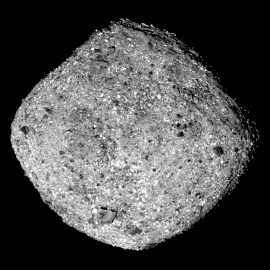
- 2–14 December – COP24 United Nations Climate Change conference in Katowice.
- 3 December – NASA reports the arrival of the OSIRIS-REx spacecraft to the carbonaceous asteroid Bennu after a two-year journey, and has determined that the asteroid interacted with water early in its history.[450][451]
- 4 December – Physcists report discovery of superconductivity at 250 K and 170 GPa.[452]
- 5 December
- An astronomer from the University of Oxford advances a new theory, related, in part, to notions of gravitationally repulsive negative masses, presented earlier by Albert Einstein, that may help better understand, in a testable manner, the considerable amounts of unknown dark matter and dark energy in the cosmos.[453][454]
- Researchers create a new algorithm, based on deep learning, that is able to solve text-based CAPTCHA tests in less than 0.05 seconds.[455]
- Scientists in the United Kingdom announce completion of the 100,000 Genomes Project.[456]
- Research published by the Global Carbon Project shows record high carbon emissions of 37.1 billion metric tons in 2018, driven by a booming market for cars and ongoing coal use in China.[457][458][459]
- 8 December – China launches Chang'e 4, the first mission to land a robotic craft on the far side of the Moon.[460]
- 10 December
- Voyager 2, a space probe launched in 1977, is confirmed (image of onboard detections) to have left the Solar System for interstellar space on 5 November 2018, six years after its sister probe, Voyager 1 (related image).[461][462]
- Four glaciers in the Vincennes Bay region of Antarctica are found to be thinning at surprisingly fast rates, casting doubt on the idea that the eastern part of the icy continent is stable.[463][464]
- Researchers announce the discovery of considerable amounts of life forms, including 70% of bacteria and archea on Earth, comprising up to 23 billion tonnes of carbon, living up to at least 4.8 km (3.0 mi) deep underground, including 2.5 km (1.6 mi) below the seabed, according to a ten-year Deep Carbon Observatory project.[465][466][467][468]
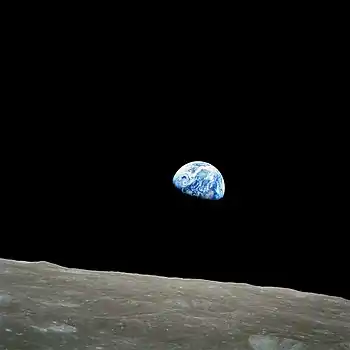
24 December: NASA celebrates the 50th Anniversary of the 1968 Christmas Eve (Earthrise) Apollo 8 trip around the moon.[469][470][471]
- 11 December – A report on the impact of climate change in the Arctic, published during the latest American Geophysical Union meeting, concludes that populations of wild reindeer, or caribou, have crashed from almost 5 million to just 2.1 million animals in the last two decades.[472][473]
- 17 December
- Astronomers led by Scott Sheppard announce the discovery of 2018 VG18, nicknamed "Farout", the most distant body ever observed in the Solar System at approximately 120 AU.[474]
- Scientists announce that the earliest feathers may have originated 250 million years ago, 70 million years earlier than previously thought.[475][476][477]
- 18 December
- Scientists report that the earliest flowers began about 180 million years ago, 50 million years earlier than previously thought.[478]
- The Kamchatka superbolide falls over the Bering Sea, near the east coast of Russia, the third largest asteroid to hit Earth since 1900. The event would not be recognized and announced until March 2019, however.[479]
- 19 December – NASA reports that the InSight lander has deployed a seismometer on Mars, the first time a seismometer has been placed onto the surface of another planet.[480]
- 24 December
- NASA celebrates the 50th Anniversary of the 1968 Christmas Eve trip around the moon by the Apollo 8 astronauts (Earthrise image).[469][470][471]
- Researchers at Tel Aviv University describe a process to make bioplastic polymers that don't require land or fresh water.[481]
Awards
- Fields Medal – Caucher Birkar, Alessio Figalli, Peter Scholze, Akshay Venkatesh
- Nobel Prize in Physiology or Medicine – James P. Allison and Tasuku Honjo, "for their discovery of cancer therapy by inhibition of negative immune regulation"
- Nobel Prize in Physics – Arthur Ashkin, Gérard Mourou and Donna Strickland, "for groundbreaking inventions in the field of laser physics"
- Nobel Prize in Chemistry – Frances H. Arnold, "for the directed evolution of enzymes", George P. Smith and Gregory P. Winter, "for the phage display of peptides and antibodies"
Deaths
- January 5 – Thomas Bopp, American astronomer (b. 1949)
- February 1 – Barys Kit, Belarusian-American rocket scientist (b. 1910)
- February 2 – Joseph Polchinski, American theoretical physicist (b. 1954)
- February 4 – Alan Baker, British mathematician (b. 1939)
- February 5 – Donald Lynden-Bell, British astrophysicist (b. 1935)
- February 10 – Alan R. Battersby, British organic chemist (b. 1925)
- February 18 – Günter Blobel, German-American biologist and Nobel Prize laureate (b. 1936)
- February 21 – Richard E. Taylor, Canadian physicist and Nobel Prize laureate (b. 1929)
- March 6 – John Sulston, British biologist and Nobel Prize laureate (b. 1942)
- March 14 – Stephen Hawking, British theoretical physicist and cosmologist (b. 1942)[482]
- April 7 – Peter Grünberg, German physicist and Nobel Prize laureate (b. 1939)
- May 26 – Ted Dabney, American engineerand computer scienties (b. 1937)
- June 29 – Arvid Carlsson, Swedish neuropharmacologist and Nobel Prize laureate (b. 1923)
- July 18 – Burton Richter, American physicist and Nobel Prize laureate (b. 1931)
- September 23 – Charles K. Kao, Hong Kong-American-British physicist and Nobel Prize laureate (b. 1933)
- October 3 - Leon M. Lederman, American physicist and Nobel Prize laureate (b. 1922)
- October 9 – Thomas A. Steitz, American biochemist and Nobel Prize laureate (b. 1940)
- December 9 – Riccardo Giacconi, Italian-American astrophysicist and Nobel Prize laureate (b. 1931)
- December 22 - Jean Bourgain, Belgian mathematician and Fields Medal laureate (b. 1954)
- December 23 - Elias M. Stein, American mathematician (b. 1931)
- December 26 - Peter Swinnerton-Dyer, English mathematician (b. 1927)
- December 26 - Roy J. Glauber, American theoretical physicist and Nobel Prize laureate (b. 1925)
Notes
- Physicist John Bell depicts the Einstein camp in this debate in his article entitled "Bertlmann's socks and the nature of reality", p. 143 of Speakable and unspeakable in quantum mechanics: "For EPR that would be an unthinkable 'spooky action at a distance'. To avoid such action at a distance they have to attribute, to the space-time regions in question, real properties in advance of observation, correlated properties, which predetermine the outcomes of these particular observations. Since these real properties, fixed in advance of observation, are not contained in quantum formalism, that formalism for EPR is incomplete. It may be correct, as far as it goes, but the usual quantum formalism cannot be the whole story." And again on p. 144 Bell says: "Einstein had no difficulty accepting that affairs in different places could be correlated. What he could not accept was that an intervention at one place could influence, immediately, affairs at the other."[349]
References
- David, Leonard (5 January 2018). "Structures on Mars". Space.com. Retrieved 5 January 2018.
- Edwards, Christopher (3 January 2018). "Sols 1913–1924: Curiosity's Working Holiday". NASA. Retrieved 6 January 2018.
- "Single metalens focuses all colors of the rainbow in one point". Harvard. 1 January 2018. Retrieved 1 January 2018.
- Shelby Rogers (7 January 2018). "Harvard Researchers Have Developed a Metalens That Could Revolutionize Optics". Interesting Engineering. Retrieved 9 January 2018.
- "Physicists build muscle for shape-changing, cell-sized robots". EurekAlert!. 2 January 2018. Retrieved 4 January 2018.
- Marc Z. Miskin; Kyle J. Dorsey; Baris Bircan; Yimo Han; David A. Muller; Paul L. McEuen; Itai Cohen (2018). "Graphene-based bimorphs for micron-sized, autonomous origami machines". Proceedings of the National Academy of Sciences. 115 (3): 466–470. Bibcode:2018PNAS..115..466M. doi:10.1073/pnas.1712889115. PMC 5776973. PMID 29295917.
- Metz, Cade; Perlroth, Nicole (3 January 2018). "Researchers Discover Two Major Flaws in the World's Computers". The New York Times. ISSN 0362-4331. Retrieved 3 January 2018.
- Warren, Tom (3 January 2018). "Intel's processors have a security bug and the fix could slow down PCs". The Verge. Retrieved 3 January 2018.
- Bright, Peter (5 January 2018). "Meltdown and Spectre: Here's what Intel, Apple, Microsoft, others are doing about it". Ars Technica. Retrieved 6 January 2018.
- Walsh, Fergus (3 January 2018). "Woman receives bionic hand with sense of touch". BBC News. Retrieved 3 January 2018.
- "Ultrafine fibers have exceptional strength". MIT. 5 January 2018. Retrieved 7 January 2018.
- "U.S. researchers develop new technique to produce ultra-strong, resilient nanofibers for protective armors". Xinhua. 7 January 2018. Retrieved 9 January 2018.
- Adamson, Allan (5 March 2018). "Scientist May Have Found Evidence Of Fossilized Alien Tracks On Planet Mars". TechTimes.com. Retrieved 5 March 2018.
- Howell, Elizabeth (6 March 2018). "No, Those Aren't Animal Tracks on Mars". Space.com. Retrieved 6 March 2018.
- McGrath, Matt (8 January 2018). "Most expensive year on record for US natural disasters". BBC News. Retrieved 9 January 2018.
- "2017 was 3rd warmest year on record for U.S". NOAA. 8 January 2018. Retrieved 9 January 2018.
- "Planets around Other Stars are like Peas in a Pod". Université de Montréal. 9 January 2018. Retrieved 18 January 2018.
- "Extra-terrestrial Hypatia stone rattles solar system status quo". 9 January 2018. Retrieved 11 January 2018.
- "You May Already Be Immune to CRISPR". The Atlantic. 9 January 2018. Retrieved 12 January 2018.
- "Most People May Already Be Immune to CRISPR". Popular Mechanics. 11 January 2018. Retrieved 12 January 2018.
- "3D printing creates super-soft structures that replicate brain and lungs". Imperial College London. 10 January 2018. Retrieved 30 January 2018.
- "Scientists 3D Print Super Soft Brain Like Tissue". The University Network. 30 January 2018. Retrieved 30 January 2018.
- "By Altering Bone Marrow, 'Training' Can Prepare Innate Immune System for Future Challenges". University of Pennsylvania. 11 January 2018. Archived from the original on 17 January 2018. Retrieved 17 January 2018.
- "NASA Team First to Demonstrate X-ray Navigation in Space". NASA. 11 January 2018. Retrieved 18 January 2018.
- Witze, Alexandra (17 January 2018). "NASA Test Proves Pulsars Can Function as a Celestial GPS". Nature. 553 (7688): 261–262. Bibcode:2018Natur.553..261W. doi:10.1038/d41586-018-00478-8. PMID 29345649. Retrieved 18 January 2018.
- "Microsoft creates AI that can read a document and answer questions about it as well as a person". Microsoft. 15 January 2018. Retrieved 22 January 2018.
- "Computers are getting better than humans at reading". CNN. 15 January 2018. Retrieved 16 January 2018.
- "Alibaba's AI Outguns Humans in Reading". Bloomberg L.P. 15 January 2018. Retrieved 16 January 2018.
- "Researchers program biomaterials with 'logic gates' that release therapeutics in response to environmental triggers". University of Washington. 15 January 2018. Retrieved 17 January 2018.
- Stadtmauer, Edward (15 January 2018). "NY-ESO-1-redirected CRISPR (TCRendo and PD1) Edited T Cells (NYCE T Cells)". US National Library of Medicine. Retrieved 18 January 2018.
- "U.S. Doctors Plan to Treat Cancer Patients Using CRISPR". MIT Technology Review. 17 January 2018. Retrieved 18 January 2018.
- "Ultra-Thin Memory Storage Device Paves Way for More Powerful Computing". University of Texas at Austin. 17 January 2018. Retrieved 18 January 2018.
- Liu, Zhen; et al. (24 January 2018). "Cloning of Macaque Monkeys by Somatic Cell Nuclear Transfer". Cell. 172 (4): 881–887.e7. doi:10.1016/j.cell.2018.01.020. PMID 29395327. Retrieved 24 January 2018.
- Normile, Dennis (24 January 2018). "These monkey twins are the first primate clones made by the method that developed Dolly". Science. doi:10.1126/science.aat1066. Retrieved 24 January 2018.
- "2017 Ranked Among Three Hottest Years Ever". Scientific American. 18 January 2018. Retrieved 19 January 2018.
- Carrington, Damian (18 January 2018). "2017 was the hottest year on record without El Niño boost". The Guardian. Retrieved 19 January 2018.
- Kaiser, Jocelyn (19 January 2018). "'Liquid biopsy' for cancer promises early detection". Science. 359 (6373): 259. Bibcode:2018Sci...359..259K. doi:10.1126/science.359.6373.259. PMID 29348215.
- Netburn, Deborah (18 January 2018). "This new blood test can detect early signs of 8 kinds of cancer". Los Angeles Times. Retrieved 18 January 2018.
- Bird, Christopher S.; Veríssimo, Ana; Magozzi, Sarah; Abrantes, Kátya G.; Aguilar, Alex; Al-Reasi, Hassan; Barnett, Adam; Bethea, Dana M.; Biais, Gérard (2018). "A global perspective on the trophic geography of sharks" (PDF). Nature Ecology & Evolution. 2 (2): 299–305. doi:10.1038/s41559-017-0432-z. hdl:2445/120429. ISSN 2397-334X. PMID 29348645. S2CID 4437883.
- "State of US science enterprise report shows US leads in S&E as China rapidly advances". US National Science Foundation. 18 January 2018. Retrieved 19 January 2018.
- "China Publishes More Scientific Articles Than the U.S". MIT Technology Review. 18 January 2018. Retrieved 19 January 2018.
- "Researchers Create First Stem Cells Using CRISPR Genome Activation". Gladstone Institutes. 18 January 2018. Retrieved 21 January 2018.
- "Researchers create first stem cells using CRISPR genome activation". Science Daily. 18 January 2018. Retrieved 21 January 2018.
- Kopperger, Enzo; List, Jonathan; Madhira, Sushi; Rothfischer, Florian; Lamb, Don C.; Simmel, Friedrich C. (19 January 2018). "A self-assembled nanoscale robotic arm controlled by electric fields". Science. 359 (6373): 296–301. Bibcode:2018Sci...359..296K. doi:10.1126/science.aao4284. PMID 29348232.
- "Amazon Go". Amazon. 22 January 2018. Retrieved 23 January 2018.
- "Amazon doesn't care if you accidentally shoplift from its cashier-less store". The Verge. 22 January 2018. Retrieved 23 January 2018.
- "People are lining up to shop at Amazon Go's new "queue-free" concept store". news.com.au. 23 January 2018. Retrieved 23 January 2018.
- "Engineers design artificial synapse for "brain-on-a-chip" hardware". MIT. 22 January 2018. Retrieved 23 January 2018.
- "An artificial synapse could make brain-on-a-chip hardware a reality". MIT Technology Review. 22 January 2018. Retrieved 23 January 2018.
- Briggs, Helen (24 January 2018). "First monkey clones created in Chinese laboratory". BBC News. Retrieved 24 January 2018.
- "Scientists Successfully Clone Monkeys; Are Humans Up Next?". The New York Times. Associated Press. 24 January 2018. Retrieved 24 January 2018.
- Herschkovitz, Israel; et al. (26 January 2018). "The earliest modern humans outside Africa". Science. 359 (6374): 456–459. Bibcode:2018Sci...359..456H. doi:10.1126/science.aap8369. PMID 29371468.
- St. Fleur, Nicholas (25 January 2018). "In Cave in Israel, Scientists Find Jawbone Fossil From Oldest Modern Human Out of Africa". The New York Times. Retrieved 30 June 2018.
- "Calico Scientists Publish Paper in eLife Demonstrating that the Naked Mole Rat's Risk of Death Does Not Increase With Age". Calico. 25 January 2018. Retrieved 27 January 2018.
- "Naked mole rats defy the biological law of aging". Science Magazine – AAAS. 26 January 2018. Retrieved 27 January 2018.
- Ruby, Graham; Smith, Megan; Buffenstein, Rochelle (25 January 2018). "Naked mole-rat mortality rates defy Gompertzian laws by not increasing with age". eLife. 7. doi:10.7554/eLife.31157. PMC 5783610. PMID 29364116.
- Robbins, Jim (13 April 2018). "Trillions Upon Trillions of Viruses Fall From the Sky Each Day". The New York Times. Retrieved 14 April 2018.
- Reche, Isabel; D'Orta, Gaetano; Mladenov, Natalie; Winget, Danielle M; Suttle, Curtis A (29 January 2018). "Deposition rates of viruses and bacteria above the atmospheric boundary layer". ISME Journal. 12 (4): 1154–1162. doi:10.1038/s41396-017-0042-4. PMC 5864199. PMID 29379178.
- Amos, Jonathan (2018-02-07). "Elon Musk's Falcon Heavy rocket launches successfully". BBC News. Retrieved 6 February 2018.
- "Polar bears could face extinction faster than thought, study says". CNN. 2 February 2018. Retrieved 3 February 2018.
- Millot, Marius; et al. (5 February 2018). "Experimental evidence for superionic water ice using shock compression". Nature Physics. 14 (3): 297–302. Bibcode:2018NatPh..14..297M. doi:10.1038/s41567-017-0017-4. OSTI 1542614. S2CID 125728756.
- Chang, Kenneth (5 February 2018). "Newly Discovered Form of Water Ice Is 'Really Strange' - Long theorized to be found in the mantles of Uranus and Neptune, the confirmation of the existence of superionic ice could lead to the development of new materials". The New York Times. Retrieved 5 February 2018.
- Zachos, Elaine (5 February 2018). "More Than a Trillion Planets Could Exist Beyond Our Galaxy – A new study gives the first evidence that exoplanets exist beyond the Milky Way". National Geographic Society. Retrieved 5 February 2018.
- Mandelbaum, Ryan F. (5 February 2018). "Scientists Find Evidence of Thousands of Planets in Distant Galaxy". Gizmodo. Retrieved 5 February 2018.
- "Sea ice tracking low in both hemispheres". NSIDC. 6 February 2018. Retrieved 16 February 2018.
- Kulkarni, S.R.; et al. (7 February 2018). "The Zwicky Transient Facility (ZTF) begins – ATel #11266". Astronomer's Telegram. Retrieved 8 February 2018.
- Ye, Quan-Zhi; et al. (8 February 2018). "First Discovery of a Small Near Earth Asteroid with ZTF (2018 CL) – ATel #11274". Astronomer's Telegram. Retrieved 8 February 2018.
- "Lab-grown eggs could aid fertility treatments". University of Edinburgh. 9 February 2018. Retrieved 10 February 2018.
- Gallagher, James (9 February 2018). "First human eggs grown in laboratory". BBC News. Retrieved 9 February 2018.
- "New antibiotic family discovered in dirt". BBC News. 13 February 2018. Retrieved 15 February 2018.
- Hu, Xiangyou; Das, Brati; Hou, Hailong; He, Wanxia; Yan, Riqiang (14 February 2018). "BACE1 deletion in the adult mouse reverses preformed amyloid deposition and improves cognitive functions". The Journal of Experimental Medicine. 215 (3): 927–940. doi:10.1084/jem.20171831. PMC 5839766. PMID 29444819.
- "Therapy successfully reverses Alzheimer's in mice, researchers report. What does that mean for humans?". Chicago Tribune. 14 February 2018. Retrieved 16 February 2018.
- "Just how big is the Andromeda galaxy?". Astronomy.com. 14 February 2018. Retrieved 15 February 2018.
- Hignett, Katherine (16 February 2018). "Physics Creates New Form Of Light That Could Drive The Quantum Computing Revolution". Newsweek. Retrieved 17 February 2018.
- Liang, Qi-Yu; et al. (16 February 2018). "Observation of three-photon bound states in a quantum nonlinear medium". Science. 359 (6377): 783–786. arXiv:1709.01478. Bibcode:2018Sci...359..783L. doi:10.1126/science.aao7293. PMC 6467536. PMID 29449489.
- "Study identifies traces of 'Taino' in present day Caribbean populations". The Jamaica Observer. Retrieved 2 March 2018.
- Staff (21 February 2018). "Study: Lead and other toxic metals found in e-cigarette 'vapors' – Potentially dangerous levels of metals leak from some e-cigarette heating coils". American Association for the Advancement of Science. Retrieved 23 February 2018.
- Olmedo, Pablo; et al. (February 2018). "Metal Concentrations in e-Cigarette Liquid and Aerosol Samples: The Contribution of Metallic Coils". Environmental Health Perspectives. 126 (2): 027010. doi:10.1289/EHP2175. PMC 6066345. PMID 29467105.
- Lardieri, Alexa (22 February 2018). "Study: Potentially Toxic Level of Metals Found in E-Cigarettes – Researchers found chemicals in e-cigarettes that can lead to cancer and brain damage". U.S. News & World Report. Retrieved 23 February 2018.
- Rubinstein, Mark L.; et al. (March 2018). "Adolescent Exposure to Toxic Volatile Organic Chemicals From E-Cigarettes". Pediatrics. 141 (4): e20173557. doi:10.1542/peds.2017-3557. PMC 5869331. PMID 29507165. Retrieved 9 March 2018.
- Gibney, Elizabeth (28 February 2018). "Astronomers detect light from the Universe's first stars − Surprises in signal from cosmic dawn also hint at presence of dark matter". Nature. doi:10.1038/d41586-018-02616-8. Retrieved 28 February 2018.
- Overbye, Dennis (28 February 2018). "When Stars Were Born: Earliest Starlight's Effects Are Detected". The New York Times. Retrieved 1 March 2018.
- Gibney, Elizabeth (5 March 2018). "Surprise graphene discovery could unlock secrets of superconductivity". Nature. 555 (7695): 151–152. Bibcode:2018Natur.555..151G. doi:10.1038/d41586-018-02773-w. PMID 29517044.
- "Insulator or superconductor? Physicists find graphene is both". MIT. 5 March 2018. Retrieved 6 March 2018.
- Gibney, Elizabeth (7 March 2018). "Surprise Graphene Discovery Could Unlock Secrets of Superconductivity". Nature. 555 (7695): 151–152. Bibcode:2018Natur.555..151G. doi:10.1038/d41586-018-02773-w. PMID 29517044. Retrieved 8 March 2018.
- "Google has built the world's most advanced quantum chip". Technology Review. 6 March 2018. Retrieved 6 March 2018.
- "A Preview of Bristlecone, Google's New Quantum Processor". Google. 5 March 2018. Retrieved 6 March 2018.
- Perkins, Sid (8 March 2018). "Pockets of water may lay deep below Earth's surface". Science. doi:10.1126/science.aat5630 (inactive 2021-01-14). Retrieved 9 March 2018.CS1 maint: DOI inactive as of January 2021 (link)
- Netburn, Deborah (9 March 2018). "What scientists found trapped in a diamond: a type of ice not known on Earth". Los Angeles Times. Retrieved 9 March 2018.
- Hermitanio, Maui (9 March 2018). "Twins Study Update: NASA Astronaut Scott Kelly's DNA Altered In Space". TechTimes.com. Retrieved 9 March 2018.
- Mlot, Stephanie (11 March 2018). "Astronaut Scott Kelly's DNA Changed in Space". Geek.com. Retrieved 12 March 2018.
- Edwards, Monica; Abadie, Laurie (31 January 2018). "NASA Twins Study Confirms Preliminary Findings". NASA. Retrieved 9 March 2018.
- Voeten, Dennis F.A.E.; et al. (13 March 2018). "Wing bone geometry reveals active flight in Archaeopteryx". Nature Communications. 9 (923): 923. Bibcode:2018NatCo...9..923V. doi:10.1038/s41467-018-03296-8. PMC 5849612. PMID 29535376.
- Guarino, Ben (13 March 2018). "This feathery dinosaur probably flew, but not like any bird you know". The Washington Post. Retrieved 13 March 2018.
- Warren, Tom (15 March 2018). "Intel processors are being redesigned to protect against Spectre – New hardware coming later this year". The Verge. Retrieved 20 March 2018.
- Shankland, Stephen (15 March 2018). "Intel will block Spectre attacks with new chips this year – Cascade Lake processors for servers, coming this year, will fight back against a new class of vulnerabilities, says CEO Brian Krzanich". CNET. Retrieved 20 March 2018.
- Smith, Ryan (15 March 2018). "Intel Publishes Spectre & Meltdown Hardware Plans: Fixed Gear Later This Year". AnandTech. Retrieved 20 March 2018.
- Coldewey, Devin (15 March 2018). "Intel announces hardware fixes for Spectre and Meltdown on upcoming chips". TechCrunch. Retrieved 28 March 2018.
- Palop, Jorge; Losa, Magdalena; Tracy, Tara; Ma, Keran; Verret, Laure; Perez, Alexandra; Khan, Abdullah; Cobos, Inma; Ho, Kaitlyn; Gan, Li; Mucke, Lennart; Dolado, Manuel (15 March 2018). "Nav1.1-Overexpressing Interneuron Transplants Restore Brain Rhythms and Cognition in a Mouse Model of Alzheimer's Disease". Neuron. 98 (1): 75–89.e5. doi:10.1016/j.neuron.2018.02.029. hdl:10261/165766. PMC 5886814. PMID 29551491. Retrieved 10 April 2018.
- "Cell Therapy Could Improve Brain Functions Impaired by Alzheimer's Disease". Gladstone Institutes. 15 March 2018. Retrieved 10 April 2018.
- "A self-driving Uber has killed a pedestrian in Arizona". Technology Review. 19 March 2018. Retrieved 19 March 2018.
- "Rewinding the clock". Harvard Medical School. 22 March 2018. Retrieved 28 March 2018.
- Graeter, K. A; Osterberg, E. C; Ferris, D. G; Hawley, R. L; Marshall, H. P; Lewis, G; Meehan, T; McCarthy, F; Overly, T; Birkel, S. D (26 March 2018). "Ice Core Records of West Greenland Melt and Climate Forcing". Geophysical Research Letters. 45 (7): 3164. Bibcode:2018GeoRL..45.3164G. doi:10.1002/2017GL076641. S2CID 53625151.
- "US soldier gets world's first penis and scrotum transplant". BBC News. 23 April 2018. Retrieved 23 April 2018.
- Staff (1 April 2018). "Tiangong-1: Defunct China space lab comes down over South Pacific". BBC News. Retrieved 1 April 2018.
- Chang, Kenneth (1 April 2018). "China's Tiangong-1 Space Station Has Fallen Back to Earth Over the Pacific". The New York Times. Retrieved 1 April 2018.
- Kelly, Patrick L.; et al. (2 April 2018). "Extreme magnification of an individual star at redshift 1.5 by a galaxy-cluster lens". Nature. 2 (4): 334–342. arXiv:1706.10279. Bibcode:2018NatAs...2..334K. doi:10.1038/s41550-018-0430-3. S2CID 125826925.
- Howell, Elizabeth (2 April 2018). "Rare Cosmic Alignment Reveals Most Distant Star Ever Seen". Space.com. Retrieved 2 April 2018.
- Lucile Pantel; et al. (5 April 2018). "Odilorhabdins, Antibacterial Agents that Cause Miscoding by Binding at a New Ribosomal Site". Cell. 70 (1): 83–94.e7. doi:10.1016/j.molcel.2018.03.001. PMID 29625040.
- Takaya, Yutaro; Yasukawa, Kazutaka; Kawasaki, Takehiro; Fujinaga, Koichiro; Ohta, Junichiro; Usui, Yoichi; Nakamura, Kentaro; Kimura, Jun-Ichi; Chang, Qing; Hamada, Morihisa; Dodbiba, Gjergj; Nozaki, Tatsuo; Iijima, Koichi; Morisawa, Tomohiro; Kuwahara, Takuma; Ishida, Yasuyuki; Ichimura, Takao; Kitazume, Masaki; Fujita, Toyohisa; Kato, Yasuhiro (10 April 2018). "The tremendous potential of deep-sea mud as a source of rare-earth elements". Scientific Reports. 8 (1): 5763. Bibcode:2018NatSR...8.5763T. doi:10.1038/s41598-018-23948-5. PMC 5893572. PMID 29636486.
- "A massive, 'semi-infinite' trove of rare-earth metals has been found in Japan". CNBC. 12 April 2018. Retrieved 12 April 2018.
- "Japan team maps 'semi-infinite' trove of rare earth elements". The Japan Times Online. 11 April 2018. Retrieved 12 April 2018.
- Thornalley, David J. R.; Oppo, Delia W.; Ortega, Pablo; Robson, Jon I.; Brierley, Chris M.; Davis, Renee; Hall, Ian R.; Moffa-Sanchez, Paola; Rose, Neil L.; Spooner, Peter T.; Yashayaev, Igor; Keigwin, Lloyd D. (11 April 2018). "Anomalously weak Labrador Sea convection and Atlantic overturning during the past 150 years". Nature. 556 (7700): 227–230. Bibcode:2018Natur.556..227T. doi:10.1038/s41586-018-0007-4. PMID 29643484. S2CID 4771341.
- Caesar, L.; Rahmstorf, S.; Robinson, A.; Feulner, G.; Saba, V. (11 April 2018). "Observed fingerprint of a weakening Atlantic Ocean overturning circulation" (PDF). Nature. 556 (7700): 191–196. Bibcode:2018Natur.556..191C. doi:10.1038/s41586-018-0006-5. PMID 29643485. S2CID 4781781.
- Editor, Damian Carrington Environment (12 April 2018). "Gulf Stream current at its weakest in 1,600 years, studies show". The Guardian. Retrieved 12 April 2018.CS1 maint: extra text: authors list (link)
- "A graphene roll-out". MIT. 17 April 2018. Retrieved 19 April 2018.
- "MIT may have just solved how to mass-produce graphene". Silicon Republic. 19 April 2018. Retrieved 19 April 2018.
- Amos, Jonathan (19 April 2018). "Planet-hunter launches from Florida". BBC News. Retrieved 19 April 2018.
- "NASA Planet Hunter on Its Way to Orbit". NASA. 19 April 2018. Retrieved 19 April 2018.
- "A robot by NTU Singapore autonomously assembles an IKEA chair". Nanyang Technological University. 19 April 2018. Retrieved 19 April 2018.
- Suárez-Ruiz, Francisco; Zhou, Xian; Pham, Quang-Cuong (18 April 2018). "Can robots assemble an IKEA chair?". Science Robotics. 3 (17): eaat6385. doi:10.1126/scirobotics.aat6385. PMID 33141740. S2CID 14017232.
- Rincon, Paul (26 April 2018). "Space agencies intent on mission to deliver Mars rocks to Earth". BBC News. Retrieved 26 April 2018.
- Walker, Robert (26 April 2018). "Likely 2040 Before Mars Samples Returned Safely, Legally – And Not Likely To Answer Astrobiology Questions". science20.com. Retrieved 27 April 2018.
- Staff (26 April 2018). "Video (02:22) – Bringing Mars Back To Earth". NASA. Retrieved 27 April 2018.
- Thompson, Alexis A.; Walters, Mark C.; Kwiatkowski, Janet; Rasko, John E.J.; Ribeil, Jean-Antoine; et al. (19 April 2018). "Gene Therapy in Patients with Transfusion-Dependent β-Thalassemia". New England Journal of Medicine. 378 (16): 1479–1493. doi:10.1056/NEJMoa1705342. PMID 29669226.
- "Thalassaemia gene therapy trial shows 'encouraging' results". BBC News. 19 April 2018. Retrieved 19 April 2018.
- "Gene therapy helps patients avoid blood transfusion, study says". CNN. 19 April 2018. Retrieved 19 April 2018.
- "Gene therapy could free some people from a lifetime of blood transfusions". MIT Technology Review. 19 April 2018. Retrieved 19 April 2018.
- "Gaia's Sky in Colour". Retrieved 2018-04-25.
- Daly, R. Terik; Schultz, Peter H. (25 April 2018). "The delivery of water by impacts from planetary accretion to present". Science Advances. 4 (4): eaar2632. Bibcode:2018SciA....4R2632D. doi:10.1126/sciadv.aar2632. PMC 5916508. PMID 29707636.
- Gorman, James (15 May 2018). "How Asteroids May Have Brought Water to Earth". The New York Times. Retrieved 16 May 2018.
- Editor, Ian Sample Science (26 April 2018). "'Gene map for depression' sparks hopes of new generation of treatments". The Guardian. Retrieved 27 April 2018.CS1 maint: extra text: authors list (link)
- "Unprecedented study identifies 44 genetic risk factors for major depression". EurekAlert!. 26 April 2018. Retrieved 27 April 2018.
- Wray, Naomi R.; Ripke, Stephan; Mattheisen, Manuel; Trzaskowski, Maciej; Byrne, Enda M.; et al. (26 April 2018). "Genome-wide association analyses identify 44 risk variants and refine the genetic architecture of major depression". Nature Genetics. 50 (5): 668–681. doi:10.1038/s41588-018-0090-3. PMC 5934326. PMID 29700475.
- "Electrons and Positrons Collide for the first time in the SuperKEKB Accelerator". 26 April 2018. Retrieved 28 April 2018.
- "Hawking's last paper co-authored with ERC grantee posits new cosmology". EurekAlert!. 2 May 2018. Retrieved 3 May 2018.
- Zimmer, Carl (4 May 2018). "The Very First Animal Appeared Amid an Explosion of DNA". The New York Times. Retrieved 4 May 2018.
- Paps, Jordi; Holland, Peter W. H. (30 April 2018). "Reconstruction of the ancestral metazoan genome reveals an increase in genomic novelty". Nature Communications. 9 (1730 (2018)): 1730. Bibcode:2018NatCo...9.1730P. doi:10.1038/s41467-018-04136-5. PMC 5928047. PMID 29712911.
- "GP-write Announces 'Ultra-safe Cells' as Featured Community Project". Genome Project-Write. 1 May 2018. Retrieved 1 May 2018.
- ""Project Recode" aims to make human cells invulnerable to infection". MIT Technology Review. 1 May 2018. Retrieved 1 May 2018.
- "Genome writing project aims to rally scientists around virus-proofing cells". Science. 1 May 2018. Retrieved 1 May 2018.
- Brown, Dwayne; Wendel, JoAnna; Agle, DC; Northon, Karen (11 May 2018). "Mars Helicopter to Fly on NASA's Next Red Planet Rover Mission". NASA. Retrieved 11 May 2018.
- Chang, Kenneth. "A Helicopter on Mars? NASA Wants to Try". The New York Times. Retrieved 12 May 2018.
- Gush, Loren (11 May 2018). "NASA is sending a helicopter to Mars to get a bird's-eye view of the planet". The Verge. Retrieved 11 May 2018.
- Georgiou, Aristos (3 May 2018). "Helium Discovered In Atmosphere Of Exoplanet For The First Time". Newsweek.
- Chang, Kenneth (5 May 2018). "NASA's InSight Launches for Six-Month Journey to Mars". The New York Times. Retrieved 5 May 2018.
- Agle, D.C.; Good, Andrew; Brown, Dwayne; Wendel, JoAnna (5 May 2018). "NASA, ULA Launch Mission to Study How Mars Was Made". Retrieved 5 May 2018.
- The BIG Bell Test Collaboration (9 May 2018). "Challenging local realism with human choices". Nature. 557 (7704): 212–216. arXiv:1805.04431. Bibcode:2018Natur.557..212B. doi:10.1038/s41586-018-0085-3. PMID 29743691. S2CID 13665914.
- Mandelbaum, Ryan F. (11 May 2018). "100,000 Video Game Players Helped Scientists Prove Einstein Wrong". Gizmodo. Retrieved 12 May 2018.
- "NASA program to track greenhouse gas is canceled (Update)". PhysOrg. 10 May 2018. Retrieved 13 May 2018.
- Jia, Xianzhe; Kivelson, Margaret G.; Khurana, Krishan K.; Kurth, William S. (14 May 2018). "Evidence of a plume on Europa from Galileo magnetic and plasma wave signatures". Nature Astronomy. 2 (6): 459. Bibcode:2018NatAs...2..459J. doi:10.1038/s41550-018-0450-z. S2CID 134370392.
- McCartney, Gretchen; Brown, Dwayne; Wendel, JoAnna (14 May 2018). "Old Data Reveal New Evidence of Europa Plumes". Retrieved 14 May 2018.
- Chang, Kenneth (14 May 2018). "NASA Finds Signs of Plumes From Europa, Jupiter's Ocean Moon". The New York Times. Retrieved 14 May 2018.
- Wall, Mike (14 May 2018). "This May Be the Best Evidence Yet of a Water Plume on Jupiter's Moon Europa". Space.com. Retrieved 14 May 2018.
- St. Fleur, Nicholas (14 May 2018). "Tiny Brains of Extinct Human Relative Had Complex Features". The New York Times. Retrieved 14 May 2018.
- Holloway, Ralph L.; Hurst, Shawn D.; Garvin, Heather M.; Schoenemann, P. Thomas; Vanti, William B.; Berger, Lee R.; Hawks, John (2018). "Endocast morphology of Homo naledi from the Dinaledi Chamber, South Africa". Proceedings of the National Academy of Sciences. 115 (22): 5738–5743. doi:10.1073/pnas.1720842115. PMC 5984505. PMID 29760068.
- Peter Farquhar (18 May 2018). "'Someone in East Asia' has been blasting the Earth's ozone layer with a banned chemical". Business Insider. Australia.
- Warren, Tom (22 May 2018). "Google and Microsoft disclose new CPU flaw, and the fix can slow machines down". The Verge. Retrieved 22 May 2018.
- Bright, Peter (22 May 2018). "New speculative-execution vulnerability strikes AMD, ARM, and Intel – Fortunately, existing fixes should provide the protection we need". Ars Technica. Retrieved 22 May 2018.
- Martindale, Jon (22 May 2018). "New Spectre-like bug could mean more performance-degrading patches". Digital Trends. Retrieved 22 May 2018.
- "CRISPR-edited rice plants produce major boost in grain yield". PhysOrg. 22 May 2018. Retrieved 23 May 2018.
- Myhrvold, Nathan (22 May 2018). "An empirical examination of WISE/NEOWISE asteroid analysis and results". Icarus. 314: 64–97. Bibcode:2018Icar..314...64M. doi:10.1016/j.icarus.2018.05.004.
- Chang, Kenneth (14 June 2018). "Asteroids and Adversaries: Challenging What NASA Knows About Space Rocks". The New York Times. Retrieved 14 June 2018.
- St. Fleur, Nicholas (23 May 2018). "Big Discovery in a Tiny Mammal-Like Skull Found Under a Dinosaur's Foot". The New York Times. Retrieved 23 May 2018.
- Huttenlocker, Adam K.; rossnickle, David M.; Kirkland, Jam,es I.; Schultz, Julia A.; Luo, Zhe-Xi (23 May 2018). "Late-surviving stem mammal links the lowermost Cretaceous of North America and Gondwana". Nature. 558 (7708): 108–112. Bibcode:2018Natur.558..108H. doi:10.1038/s41586-018-0126-y. PMID 29795343. S2CID 43921185.
- Chinoy, Sahil (24 May 2018). "The Places in the U.S. Where Disaster Strikes Again and Again". The New York Times. Retrieved 24 May 2018.
- Wall, Mike (24 May 2018). "Pluto May Have Formed from 1 Billion Comets". Space.com. Retrieved 24 May 2018.
- Glein, Christopher R.; Waite, Jr, J. Hunter (2018). "Primordial N2 provides a cosmochemical explanation for the existence of Sputnik Planitia, Pluto". Icarus. 313 (2018): 79–92. arXiv:1805.09285. Bibcode:2018Icar..313...79G. doi:10.1016/j.icarus.2018.05.007. S2CID 102343522.
- "Climate change could increase arable land". University of Leeds. 24 May 2018. Retrieved 25 May 2018.
- "3D printed human corneas created at Newcastle University". FT. 30 May 2018. Retrieved 31 May 2018.
- "FDA approves first artificial iris" (Press release). FDA. 30 May 2018. Retrieved 1 June 2018.
- Letzter, Rafi (1 June 2018). "A Major Physics Experiment Just Detected A Particle That Shouldn't Exist". LiveScience. Retrieved 3 June 2018.
- Aguilar-Arevalo, A. A.; Brown, B. C.; Bugel, L.; Cheng, G.; Conrad, J. M.; et al. (MiniBooNE Collaboration) (2018). "Observation of a Significant Excess of Electron-Like Events in the MiniBooNE Short-Baseline Neutrino Experiment". Phys. Rev. Lett. 121 (22): 221801. arXiv:1805.12028. Bibcode:2018PhRvL.121v1801A. doi:10.1103/PhysRevLett.121.221801. PMID 30547637. S2CID 53999758.
- Wall, Mike (12 June 2018). "NASA's Curiosity Rover Is Tracking a Huge Dust Storm on Mars (Photo)". Space.com. Retrieved 13 June 2018.
- Good, Andrew; Brown, Dwayne; Wendell, JoAnna (June 12, 2018). "NASA to Hold Media Teleconference on Martian Dust Storm, Mars Opportunity Rover". NASA. Retrieved June 12, 2018.
- Malik, Tariq (13 June 2018). "As Massive Storm Rages on Mars, Opportunity Rover Falls Silent – Dust clouds blotting out the sun could be the end of the solar-powered probe". Scientific American. Retrieved 13 June 2018.
- Good, Andrew (13 June 2018). "NASA Encounters the Perfect Storm for Science". NASA. Retrieved 14 June 2018.
- NASA Staff (13 June 2018). "Mars Dust Storm News – Teleconference – audio (065:22)". NASA. Retrieved 13 June 2018.
- Shekhtman, Lonnie; Good, Andrew (20 June 2018). "Martian Dust Storm Grows Global; Curiosity Captures Photos of Thickening Haze". NASA. Retrieved 21 June 2018.
- Malik, Tariq (21 June 2018). "Epic Dust Storm on Mars Now Completely Covers the Red Planet". Space.com. Retrieved 21 June 2018.
- "New ATLAS result establishes production of Higgs boson in association with top quarks". 4 June 2018. Retrieved 8 June 2018.
- "Direct Coupling of the Higgs Boson to the Top Quark Observed". University of Zurich. 4 June 2018. Retrieved 5 June 2018.
- "Case Western Reserve University School of Medicine Researchers Create First Artificial Human Prion". Case Western Reserve University School of Medicine. 5 June 2018. Retrieved 12 June 2018.
- "Oldest 'footprints' found in China". BBC News. 7 June 2018. Retrieved 8 June 2018.
- Rayman, Marc (13 June 2018). "Dawn – Mission Status". NASA. Retrieved 16 June 2018.
- Clark, Stephen (15 June 2018). "Dawn spacecraft flying low over Ceres". SpaceFlightNow.com. Retrieved 16 June 2018.
- Brown, Dwayne; Wendel, JoAnna; Steigerwald, Bill; Jones, Nancy; Good, Andrew (7 June 2018). "Release 18-050 – NASA Finds Ancient Organic Material, Mysterious Methane on Mars". NASA. Retrieved 7 June 2018.
- NASA (7 June 2018). "Ancient Organics Discovered on Mars – video (03:17)". NASA. Retrieved 7 June 2018.
- Wall, Mike (7 June 2018). "Curiosity Rover Finds Ancient 'Building Blocks for Life' on Mars". Space.com. Retrieved 7 June 2018.
- Chang, Kenneth (7 June 2018). "Life on Mars? Rover's Latest Discovery Puts It 'On the Table' - The identification of organic molecules in rocks on the red planet does not necessarily point to life there, past or present, but does indicate that some of the building blocks were present". The New York Times. Retrieved 8 June 2018.
- Voosen, Paul (7 June 2018). "NASA rover hits organic pay dirt on Mars". Science. doi:10.1126/science.aau3992. Retrieved 7 June 2018.
- ten Kate, Inge Loes (8 June 2018). "Organic molecules on Mars". Science. 360 (6393): 1068–1069. Bibcode:2018Sci...360.1068T. doi:10.1126/science.aat2662. PMID 29880670. S2CID 46952468.
- Webster, Christopher R.; et al. (8 June 2018). "Background levels of methane in Mars' atmosphere show strong seasonal variations". Science. 360 (6393): 1093–1096. Bibcode:2018Sci...360.1093W. doi:10.1126/science.aaq0131. PMID 29880682.
- Eigenbrode, Jennifer L.; et al. (8 June 2018). "Organic matter preserved in 3-billion-year-old mudstones at Gale crater, Mars". Science. 360 (6393): 1096–1101. Bibcode:2018Sci...360.1096E. doi:10.1126/science.aas9185. PMID 29880683.
- "ORNL Launches Summit Supercomputer". Oak Ridge National Laboratory. 8 June 2018. Retrieved 9 June 2018.
- "Summit Up and Running at Oak Ridge, Claims First Exascale Application". Top500. 9 June 2018. Retrieved 9 June 2018.
- "The Karlsruhe Tritium Neutrino Experiment KATRIN Starts – Official Inauguration Colloquium on June 11 – Germany's Federal Minister of Research: "an experiment of superlatives"". 11 June 2018. Retrieved 13 June 2018.
- "Gene-edited pigs are resistant to billion dollar virus, study finds". University of Edinburgh. 20 June 2018. Archived from the original on 4 July 2018. Retrieved 20 June 2018.
- "From a distance of about 700 km, Ryugu's rotation was observed". Japan Aerospace Exploration Agency. 16 June 2018. Retrieved 20 June 2018.
- Staff (26 June 2018). "Scientists Confused: A Huge Explosion Has Been Observed In Space". Tech2.org. Retrieved 26 June 2018.
- Smartt, S.J.; et al. (17 June 2018). "ATLAS18qqn (AT2018cow) – a bright transient spatially coincident with CGCG 137-068 (60 Mpc)". The Astronomer's Telegram. 11727: 1. Bibcode:2018ATel11727....1S. Retrieved 22 June 2018.
- Kaplan, Sarah (25 June 2018). "'I've never seen anything like this': Astronomers dazzled by brilliant supernova". The Washington Post. Retrieved 25 June 2018.
- Crane, Leah (21 June 2018). "We've just seen a huge space explosion and don't know what it is". New Scientist. Retrieved 22 June 2018.
- Staff (22 June 2018). "The Astronomer's Telegram – Main Page (22 June 2018)". The Astronomer's Telegram. Archived from the original on 22 June 2018. Retrieved 22 June 2018.
- Bishop, David (22 June 2018). "Latest SuperNovae". RochesterAstronomy.org. Retrieved 22 June 2018.
- Bishop, David (22 June 2018). "Supernovae 2018cow in CGCG 137-068". RochesterAstronomy.org. Retrieved 22 June 2018.
- Perley, D. A.; Blagorodnova, N.; Neill, J. D.; Walters, R. (25 June 2018). "AT2018cow: Continued optical fading and weakening of spectral features". The Astronomer's Telegram. 11776 (11776): 1. Bibcode:2018ATel11776....1P. Retrieved 25 June 2018.
- "Faster analysis of medical images". MIT. 18 June 2018. Retrieved 20 June 2018.
- Staff (21 June 2018). "National Near-Earth Object Preparedness Strategy Action Plan" (PDF). White House. Retrieved 22 June 2018.
- Mandelbaum, Ryan F. (21 June 2018). "America Isn't Ready to Handle a Catastrophic Asteroid Impact, New Report Warns". Gizmodo. Retrieved 22 June 2018.
- Chang, Kenneth (14 June 2018). "Asteroids and Adversaries: Challenging What NASA Knows About Space Rocks – Relevant Comments". The New York Times. Retrieved 22 June 2018.
- "Researchers develop synthetic T cells that mimic form, function of human version". PhysOrg. 26 June 2018. Retrieved 28 June 2018.
- Overbye, Dennis (27 June 2018). "Oumuamua Is a Comet, Really". The New York Times. Retrieved 27 June 2018.
- Witze, Alexandra (27 June 2018). "Mysterious interstellar visitor is a comet — not an asteroid – Quirks in 'Oumuamua's path through the Solar System helped researchers solve a case of mistaken identity". Nature. doi:10.1038/d41586-018-05552-9. Retrieved 27 June 2018.
- Cofield, Calla; Chou, Felicia; Wendel, JoAnna; Weaver, Donna; Villard, Ray (27 June 2018). "Our Solar System's First Known Interstellar Object Gets Unexpected Speed Boost". NASA. Retrieved 27 June 2018.
- Postberg, Frank; et al. (27 June 2018). "Macromolecular organic compounds from the depths of Enceladus". Nature. 558 (7711): 564–568. Bibcode:2018Natur.558..564P. doi:10.1038/s41586-018-0246-4. PMC 6027964. PMID 29950623.
- McCartney, Gretchen; Brown, Dwayne; Wendel, JoAnna; Bauer, Markus (27 June 2018). "Complex Organics Bubble up from Enceladus". NASA. Retrieved 27 June 2018.
- ESO (2 July 2018). "First confirmed image of newborn planet caught with ESO's VLT – Spectrum reveals cloudy atmosphere". EurekAlert!. Retrieved 2 July 2018.
- Müller, A.; et al. (2018). "Orbital and atmospheric characterization of the planet within the gap of the PDS 70 transition disk" (PDF). Astronomy and Astrophysics. 617: L2. arXiv:1806.11567. Bibcode:2018A&A...617L...2M. doi:10.1051/0004-6361/201833584. S2CID 49561725. Retrieved 2 July 2018.
- Keppler, M.; et al. "Discovery of a planetary-mass companion within the gap of the transition disk around PDS 70 ?" (PDF). ESO. Retrieved 2 July 2018.
- Johnson, Rebecca N.; et al. (2 July 2018). "Adaptation and conservation insights from the koala genome". Nature Genetics. 50 (8): 1102–1111. doi:10.1038/s41588-018-0153-5. hdl:2433/232590. PMC 6197426. PMID 29967444.
- "Rising carbon dioxide levels pose a previously unrecognized threat to monarch butterflies". Science Daily. 10 July 2018. Retrieved 11 July 2018.
- Zimmer, Carl (11 July 2018). "Archaeologists in China Discover the Oldest Stone Tools Outside Africa – Chipped rocks found in western China indicate that human ancestors ventured from Africa earlier than previously believed". The New York Times. Retrieved 13 July 2018.
- Overbye, Dennis (12 July 2018). "It Came From a Black Hole, and Landed in Antarctica – For the first time, astronomers followed cosmic neutrinos into the fire-spitting heart of a supermassive blazar". The New York Times. Retrieved 13 July 2018.
- Sample, Ian (12 July 2018). "Neutrino that struck Antarctica traced to galaxy 3.7bn light years away". The Guardian. Retrieved 12 July 2018.
- Halton, Mary (12 July 2018). "Source of cosmic 'ghost' particle revealed". BBC. Retrieved 12 July 2018.
- "Hubble and Gaia team up to fuel cosmic conundrum". Science Daily. 18 July 2018. Retrieved 18 July 2018.
- "Buried Internet infrastructure at risk as sea levels rise". Science Daily. 17 July 2018. Retrieved 17 July 2018.
- Sample, Ian (17 July 2018). "Astronomers discover 12 new moons orbiting Jupiter – one on collision course with the others". The Guardian. Retrieved 17 July 2018.
- "A dozen new moons of Jupiter discovered, including one 'oddball'". EurekAlert!. 17 July 2018. Retrieved 17 July 2018.
- "Complete fly brain imaged at nanoscale resolution". PhysOrg. 19 July 2018. Retrieved 21 July 2018.
- Ojha, Lujendra; Lewis, Kevin; Karunatillake, Suniti; Schmidt, Mariek (20 July 2018). "The Medusae Fossae Formation as the single largest source of dust on Mars". Nature Communications. 9 (2867 (2018)): 2867. Bibcode:2018NatCo...9.2867O. doi:10.1038/s41467-018-05291-5. PMC 6054634. PMID 30030425.
- "Scientists reverse aging-associated skin wrinkles and hair loss in a mouse model". Science Daily. 20 July 2018. Retrieved 21 July 2018.
- "Warming temperatures could increase suicide rates across the US and Mexico". Science Daily. 23 July 2018. Retrieved 24 July 2018.
- "Scientists perfect technique to boost capacity of computer storage a thousand-fold". Science Daily. 23 July 2018. Retrieved 24 July 2018.
- Achal, Roshan; Rashidi, Mohammad; Croshaw, Jeremiah; Churchill, David; Taucer, Marco; Huff, Taleana; Cloutier, Martin; Pitters, Jason; Wolkow, Robert A. (23 July 2018). "Lithography for robust and editable atomic-scale silicon devices and memories". Nature Communications. 9 (1): 2778. Bibcode:2018NatCo...9.2778A. doi:10.1038/s41467-018-05171-y. PMC 6056515. PMID 30038236.
- Orosei, R.; et al. (25 July 2018). "Radar evidence of subglacial liquid water on Mars". Science. 361 (6401): 490–493. arXiv:2004.04587. Bibcode:2018Sci...361..490O. doi:10.1126/science.aar7268. hdl:11573/1148029. PMID 30045881.
- Chang, Kenneth; Overbye, Dennis (25 July 2018). "A Watery Lake Is Detected on Mars, Raising the Potential for Alien Life – The discovery suggests that watery conditions beneath the icy southern polar cap may have provided one of the critical building blocks for life on the red planet". The New York Times. Retrieved 25 July 2018.
- "Huge reservoir of liquid water detected under the surface of Mars". EurekAlert. 25 July 2018. Retrieved 25 July 2018.
- The Editorial Board (1 August 2018). "Mars Close Up – Look skyward and dream". The New York Times. Archived from the original on 2018-08-02. Retrieved 1 August 2018.
- "NASA's TESS Spacecraft Starts Science Operations". NASA. 27 July 2018. Retrieved 28 July 2018.
- "New two-dimensional material could revolutionize solar fuel generation". Science Daily. 25 July 2018. Retrieved 2 August 2018.
- Gill, Victoria (28 July 2018). "Lunar eclipse: Century's longest 'blood moon' delights skygazers". BBC News. Retrieved 28 July 2018.
- "Artificial intelligence can predict your personality ... simply by tracking your eyes". Science Daily. 28 July 2018. Retrieved 30 July 2018.
- "Largest king penguin colony has shrunk nearly 90%". Science Daily. 30 July 2018. Retrieved 30 July 2018.
- "Mars terraforming not possible using present-day technology". EurekAlert!. 30 July 2018. Retrieved 31 July 2018.
- "Astronomers discover a free-range planet with incredible magnetism". Astronomy.com. 3 August 2018. Retrieved 6 August 2018.
- Barras, Colin (8 August 2018). "These half-billion-year-old creatures were animals—but unlike any known today". Science. doi:10.1126/science.aav0347. Retrieved 8 August 2018.
- MacDonald, Fiona (6 August 2018). "Astronomers Have Detected an Intense And Mysteriously Low Frequency Radio Signal Coming From Space". SciencAlert.com. Retrieved 6 August 2018.
- Boyle, P.J. (1 August 2018). "First detection of fast radio bursts between 400 and 800 MHz by CHIME/FRB". The Astronomer's Telegram (11901). Retrieved 6 August 2018.
- "Lab-grown lungs transplanted into pigs". Science. 6 August 2018. Retrieved 9 August 2018.
- Gladstone, G. Randall; et al. (7 August 2018). "The Lyman-α Sky Background as Observed by New Horizons". Geophysical Research Letters. 45 (16): 8022–8028. arXiv:1808.00400. Bibcode:2018GeoRL..45.8022G. doi:10.1029/2018GL078808. S2CID 119395450.
- Letzter, Rafi (9 August 2018). "NASA Spotted a Vast, Glowing 'Hydrogen Wall' at the Edge of Our Solar System". Live Science. Retrieved 10 August 2018.
- Hoyal Cuthill, Jennifer H.; Han, Jian (2018). "Cambrian petalonamid Stromatoveris phylogenetically links Ediacaran biota to later animals" (PDF). Palaeontology. 61 (6): 813–823. doi:10.1111/pala.12393.
- Vincent, James (8 August 2018). "AI spots 40,000 prominent scientists overlooked by Wikipedia – The softwares scans news stories to find overlooked figures, and even writes a draft article about them". The Verge. Retrieved 8 August 2018.
- Meng, Lingxian; Zhang, Yamin; Wan, Xiangjian; Li, Chenxi; Zhang, Xin; Wang, Yanbo; Ke, Xin; Xiao, Zuo; Ding, Liming; Xia, Ruoxi; Yip, Hin-Lap; Cao, Yong; Chen, Yongsheng (9 August 2018). "Organic and solution-processed tandem solar cells with 17.3% efficiency". Science. 361 (6407): 1094–1098. Bibcode:2018Sci...361.1094M. doi:10.1126/science.aat2612. PMID 30093603.
- "Organic solar cells set 'remarkable' energy record", BBC News, 9 August 2018, retrieved 15 August 2018
- Chang, Kenneth (12 August 2018). "Parker Solar Probe Launches on NASA Voyage to 'Touch the Sun'". The New York Times. Retrieved 12 August 2018.
- Chang, Kenneth (10 August 2018). "NASA's Parker Solar Probe Is Named for Him. 60 Years Ago, No One Believed His Ideas About the Sun – Eugene N. Parker predicted the existence of solar wind in 1958. The NASA spacecraft is the first named for a living person". The New York Times. Retrieved 12 August 2018.
- Fox, N. J.; Velli, M. C.; Bale, S. D.; Decker, R.; Driesman, A.; Howard, R. A.; Kasper, J. C.; Kinnison, J.; Kusterer, M.; Lario, D.; Lockwood, M. K.; McComas, D. J.; Raouafi, N. E.; Szabo, A. (2015-11-11). "The Solar Probe Plus Mission: Humanity's First Visit to Our Star". Space Science Reviews. 204 (1–4): 7–48. Bibcode:2016SSRv..204....7F. doi:10.1007/s11214-015-0211-6. ISSN 0038-6308.
- Haggard, Daryl; Nynka, Melania; Ruan, J. J. (13 August 2018). "Chandra X-ray observations of GW170817 at 1 year post-merger: increasingly rapid fading". The Astronomer's Telegram. Retrieved 13 August 2018.
- "Foreshadow – Breaking the Virtual Memory Abstraction with Transient Out-of-Order Execution". ForeShadowAttack.eu. 14 August 2018. Retrieved 14 August 2018.
- Kan, Michael (14 August 2018). "New 'Foreshadow' Flaw Exploits Intel Chips To Steal Protected Data – The new vulnerability builds on research related to the Meltdown and Spectre flaws. Foreshadow can be exploited to read data from Intel's SGX technology, while a separate variant can break the security protections in data centers that run virtual machines". PC Magazine. Retrieved 14 August 2018.
- Bright, Peter (14 August 2018). "Intel's SGX blown wide open by, you guessed it, a speculative execution attack – Speculative execution attacks truly are the gift that keeps on giving". Ars Technica. Retrieved 14 August 2018.
- "Excavation begins on Giant Magellan Telescope site in Chile", GMTO, 14 August 2018, retrieved 18 August 2018
- "Iron and titanium in the atmosphere of an exoplanet", Science Daily, 15 August 2018, retrieved 16 August 2018
- Chang, Kenneth (16 August 2018). "Settling Arguments About Hydrogen With 168 Giant Lasers – Scientists at Lawrence Livermore National Laboratory said they were "converging on the truth" in an experiment to understand hydrogen in its liquid metallic state". The New York Times. Retrieved 18 August 2018.
- Carnegie Institution for Science (16 August 2018). "Under pressure, hydrogen offers a reflection of giant planet interiors – Hydrogen is the most-abundant element in the universe and the simplest, but that simplicity is deceptive". Science Daily. Retrieved 18 August 2018.
- "The wheat code is finally cracked", EurekAlert!, 16 August 2018, retrieved 18 August 2018
- "Most wear-resistant metal alloy in the world engineered at Sandia National Laboratories", Sandia National Laboratories, 16 August 2018, retrieved 19 August 2018
- "Water-worlds are common: Exoplanets may contain vast amounts of water", Science Daily, 18 August 2018, retrieved 19 August 2018
- University of Bristol (20 August 2018). "A timescale for the origin and evolution of all of life on Earth". Phys.org. Retrieved 20 August 2018.
- Betts, Holly C.; Putick, Mark N.; Clark, James W.; Williams, Tom A.; Donoghue, Philip C.J.; Pisani, Davide (20 August 2018). "Integrated genomic and fossil evidence illuminates life's early evolution and eukaryote origin". Nature. 2 (10): 1556–1562. doi:10.1038/s41559-018-0644-x. PMC 6152910. PMID 30127539.
- Gallardo-Lacourt, B.; Liang, J.; Nishimura, Y.; Donovan, E. (20 August 2018). "On the Origin of STEVE: Particle Precipitation or Ionospheric Skyglow?". Geophysical Research Letters. 45 (16): 7968. Bibcode:2018GeoRL..45.7968G. doi:10.1029/2018GL078509.
- "Scientists discover first direct evidence of surface exposed water ice on the moon", EurekAlert!, 21 August 2018, retrieved 22 August 2018
- Warren, Matthew (22 August 2018). "Mum's a Neanderthal, Dad's a Denisovan: First discovery of an ancient-human hybrid - Genetic analysis uncovers a direct descendant of two different groups of early humans". Nature. 560 (7719): 417–418. Bibcode:2018Natur.560..417W. doi:10.1038/d41586-018-06004-0. PMID 30135540.
- Zimmer, Carl (22 August 2018). "A Blended Family: Her Mother Was Neanderthal, Her Father Something Else Entirely - Genetic analysis of bones discovered in a Siberian cave hint that the prehistoric world may have been filled with "hybrid" humans". The New York Times. Retrieved 22 August 2018.
- Marshall, Michael (22 August 2018). "Prehistoric girl had parents belonging to different human species". New Scientist. Retrieved 22 August 2018.
- Byrd, Deborah (21 August 2018). "Researchers find fast flip in Earth's magnetic field". EarthSky. Retrieved 22 August 2018.
- Atlas Collaboration (28 August 2018). "ATLAS observes elusive Higgs boson decay to a pair of bottom quarks". Cern. Retrieved 28 August 2018.
- "Hong Kong researchers develop transformable nano-robots to perform medical tasks", Xinhuanet, 30 August 2018, retrieved 31 August 2018
- "CUHK Engineers: Nano-robots Swarm Learn Collective Morphological Transformation on Animals with Huge Potential for Biomedical Applications", The Chinese University of Hong Kong, 30 August 2018, retrieved 5 September 2018
- Wall, Mike (4 September 2018). "Bizarre Hexagon on Saturn May Be 180 Miles Tall". Space.com. Retrieved 4 September 2018.
- Fletcher, L.N.; et al. (3 September 2018). "A hexagon in Saturn's northern stratosphere surrounding the emerging summertime polar vortex". Nature Communications. 9 (3564): 3564. arXiv:1809.00572. Bibcode:2018NatCo...9.3564F. doi:10.1038/s41467-018-06017-3. PMC 6120878. PMID 30177694.
- "Large-scale wind and solar power 'could green the Sahara'", BBC News, 7 September 2018, retrieved 7 September 2018
- "Large wind and solar farms in the Sahara would increase heat, rain, vegetation", EurekAlert!, 6 September 2018, retrieved 7 September 2018
- Stirone, Shannon (7 September 2018). "New Antarctica Map Is Like 'Putting on Glasses for the First Time and Seeing 20/20' – A high resolution terrain map of Earth's frozen continent will help researchers better track changes on the ice as the planet warms". The New York Times. Retrieved 9 September 2018.
- Liang, Qi-Yu; Venkatramani, Aditya V.; Cantu, Sergio H.; Nicholson, Travis L.; Gullans, Michael J.; Gorshkov, Alexey V.; Thompson, Jeff D.; Chin, Cheng; Lukin, Mikhail D.; Vuletic, Vladan (7 September 2018). "The Sands of Phobos: The Martian moon's eccentric orbit refreshes its surface". Nature Geoscience. 12: 229–234. arXiv:1809.02520. doi:10.1038/s41561-019-0323-9. S2CID 134841669.
- Zhang, Yunfan Gerry; Gajjar, Vishal; Foster, Griffin; Siemion, Andrew; Cordes, James; Law, Casey; Wang, Yu (9 September 2018). "Fast Radio Burst 121102 Pulse Detection and Periodicity: A Machine Learning Approach". The Astrophysical Journal. 866 (2): 149. arXiv:1809.03043. Bibcode:2018ApJ...866..149Z. doi:10.3847/1538-4357/aadf31. S2CID 117337002.
- Wall, Mike (11 September 2018). "Mysterious Light Flashes Are Coming from Deep Space, and AI Just Found More of Them". Space.com. Retrieved 11 September 2018.
- Starr, Michelle (11 September 2018). "Astronomers Have Detected an Astonishing 72 New Mystery Radio Bursts From Space – We still have no idea what these signals are". ScienceAlert.com. Retrieved 11 September 2018.
- Stein, Rob (16 September 2018). "Study: A Daily Baby Aspirin Has No Benefit For Healthy Older People". NPR News. Retrieved 16 September 2018.
- McNeil, John J.; et al. (16 September 2018). "Effect of Aspirin on Disability-free Survival in the Healthy Elderly" (PDF). The New England Journal of Medicine. 379 (16): 1499–1508. doi:10.1056/NEJMoa1800722. hdl:1885/154654. PMC 6426126. PMID 30221596.
- McGregor, Veronica; Brown, Dwight; Wendel, JoAnna (10 September 2018). "And the Emmy goes to: Cassini's Grand Finale". NASA. Retrieved 10 September 2018.
- "Robot can pick up any object after inspecting it", Science Daily, 10 September 2018, retrieved 12 September 2018
- "Discovered: Optimal magnetic fields for suppressing instabilities in tokamaks", PhysOrg, 10 September 2018, retrieved 13 September 2018
- St. Fleur, Nicholas (12 September 2018). "Oldest Known Drawing by Human Hands Discovered in South African Cave". The New York Times. Retrieved 12 September 2018.
- "ICESat: Space will get unprecedented view of Earth's ice", BBC News, 15 September 2018, retrieved 15 September 2018
- Moskvitch, Katia (16 September 2018). "Astronomers Have Found The Universe's Missing Matter – For decades, some of the atomic matter in the universe had not been located. Recent papers reveal where it's been hiding". Wired. Retrieved 16 September 2018.
- Kazmierczak, Jeanette; Garner, Rob (17 September 2018). "NASA's TESS Shares First Science Image in Hunt to Find New Worlds". NASA. Retrieved 23 September 2018.
- Wiessinger, Scott; Lepsch, Aaron E.; Kazmierczak, Jeanette; Reddy, Francis; Boyd, Padi (17 September 2018). "NASA's TESS Releases First Science Image". NASA. Retrieved 23 September 2018.
- Overbye, Dennis (20 September 2018). "NASA's TESS Starts Collecting Planets – The satellite, launched in April, has already identified at least 73 stars that may harbor exoplanets, most of them new to astronomers". NASA. Retrieved 23 September 2018.
- Liang, Qi-Yu; Venkatramani, Aditya V.; Cantu, Sergio H.; Nicholson, Travis L.; Gullans, Michael J.; Gorshkov, Alexey V.; Thompson, Jeff D.; Chin, Cheng; Lukin, Mikhail D.; Vuletic, Vladan (2018). "Plausible home stars of the interstellar object 'Oumuamua found in Gaia DR2". The Astronomical Journal. 156 (5): 205. arXiv:1809.09009. Bibcode:2018AJ....156..205B. doi:10.3847/1538-3881/aae3eb. S2CID 119051284.
- "Scientists Grow Human Esophagus in Lab", Cincinnati Children's Hospital Medical Center, 20 September 2018, retrieved 30 September 2018
- "Researchers identify human skeletal stem cells", EurekAlert!, 20 September 2018, retrieved 20 September 2018
- "Fat from 558 million years ago reveals earliest known animal", Science Daily, 20 September 2018, retrieved 21 September 2018
- "Build walls on seafloor to stop glaciers melting, scientists say", The Guardian, 20 September 2018, retrieved 21 September 2018
- "Matter falling into a black hole at 30 percent of the speed of light", Science Daily, 20 September 2018, retrieved 26 September 2018
- "Japanese Probe Drops Tiny Hopping Robots Toward Big Asteroid Ryugu", Space.com, 21 September 2018, retrieved 21 September 2018
- McCartney, Gretchen; Brown, Dwayne; Wendel, JoAnna; Bauer, Markus (24 September 2018). "Dust Storms on Titan Spotted for the First Time". NASA. Retrieved 24 September 2018.
- "Dust storms on Titan spotted by Cassini for the first time", ESA, 24 September 2018, retrieved 24 September 2018
- Rafikov, Roman R. (20 September 2018). "Spin Evolution and Cometary Interpretation of the Interstellar Minor Object 1I/2017 'Oumuamua". The Astrophysical Journal. 867 (1): L17. arXiv:1809.06389. Bibcode:2018ApJ...867L..17R. doi:10.3847/2041-8213/aae977. S2CID 119346078.
- Skibba, Ramin (10 October 2018). "Interstellar Visitor Found to Be Unlike a Comet or an Asteroid". Quanta Magazine. Retrieved 10 October 2018.
- Hansford, James P.; Turvey, Samuel T. (26 September 2018). "Unexpected diversity within the extinct elephant birds (Aves: Aepyornithidae) and a new identity for the world's largest bird". Royal Society Open Science. 5 (9): 181295. Bibcode:2018RSOS....581295H. doi:10.1098/rsos.181295. PMC 6170582. PMID 30839722.
- Zoological Society of London (25 September 2018). "ZSL names world's largest ever bird -- Vorombe titan – Madagascar's giant elephant birds receive 'bone-afide' rethink". EurekAlert!. Retrieved 26 September 2018.
- Quenqua, Douglas (26 September 2018). "The Elephant Bird Regains Its Title as the Largest Bird That Ever Lived – A study finds that one member of a previously unidentified genus of the birds could have weighed more than 1,700 pounds". The New York Times. Retrieved 26 September 2018.
- O'Connor, Anahad (25 September 2018). "Fish Oil Drug May Reduce Heart Attack and Stroke Risks for Some – Large doses of an omega-3 fatty acid in fish oil sharply reduced the rate of cardiovascular events in people with a history of heart disease or Type 2 diabetes". The New York Times. Retrieved 25 September 2018.
- University of Hawaii at Manoa (26 September 2018). "Did key building blocks for life come from deep space? - Phosphates, a key building block for life, was found to be generated in outer space and delivered to early Earth by meteorites or comets". Eurekalert!. Retrieved 27 September 2018.
- "PCB pollution threatens to wipe out killer whales", EurekAlert!, 27 September 2018, retrieved 28 September 2018
- "The Nobel Prize in Physiology or Medicine 2018", The Nobel Prize, 1 October 2018, retrieved 1 October 2018
- Griffin, Andrew (2 October 2018). "Travelling to Mars and deep into space could kill astronauts by destroying their guts, finds Nasa-funded study - Previous work has shown that astronauts could age prematurely and have damaged brain tissue after long journeys". The Independent. Retrieved 2 October 2018.
- Kumar, Santosh; et al. (1 October 2018). "Space radiation triggers persistent stress response, increases senescent signaling, and decreases cell migration in mouse intestine". PNAS. 115 (42): E9832–E9841. Bibcode:2018PNAS..115E9832K. doi:10.1073/pnas.1807522115. PMC 6196540. PMID 30275302.
- Gruch, Loren (2 October 2018). "The Search For planet X Gets A Boost With The Discovery Of A Super Distant Object - The edge of our cosmic neighborhood is slowly coming into focus". The Verge. Retrieved 2 October 2018.
- Chang, Kenneth (2 October 2018). "A Goblin World That Points Toward Hidden Planet Nine in the Solar System - What astronomers have found about the curious orbit of a small ice world far away reinforces the idea that a large world is hidden out in the solar system". The New York Times. Retrieved 2 October 2018.
- Teachey, Alex; Kipping, David M. (3 October 2018). "Evidence for a large exomoon orbiting Kepler-1625b". Science. 4 (10): eaav1784. arXiv:1810.02362. Bibcode:2018SciA....4.1784T. doi:10.1126/sciadv.aav1784. PMC 6170104. PMID 30306135.
- Drake, Nadia (3 October 2018). "Weird giant may be the first known alien moon - Evidence is mounting that a world the size of Neptune could be orbiting a giant planet far, far away". National Geographic Society. Retrieved 4 October 2018.
- "The Nobel Prize in Physics 2018". Nobel Foundation. Retrieved 2 October 2018.
- "Gaia spots stars flying between galaxies", Royal Astronomical Society, 2 October 2018, retrieved 2 October 2018
- Press Release: The Nobel Prize in Chemistry 2018
- "Astronomers find first compelling evidence for a moon outside our solar system", Science Daily, 3 October 2018, retrieved 4 October 2018
- "First 'exomoon' may have been found", BBC News, 4 October 2018, retrieved 4 October 2018
- Balch, Erica (4 October 2018). "Ground-breaking lab poised to unlock the mystery of the origins of life on Earth and beyond". McMaster University. Retrieved 4 October 2018.
- Staff (4 October 2018). "Ground-breaking lab poised to unlock the mystery of the origins of life". EurekAlert!. Retrieved 14 October 2018.
- Staff (2018). "Planet Simulator". IntraVisionGroup.com. Retrieved 14 October 2018.
- Anderson, Paul Scott (14 October 2018). "New technology may help solve mystery of life's origins - How did life on Earth begin? A new technology, called Planet Simulator, might finally help solve the mystery". EarthSky. Retrieved 14 October 2018.
- "Hubble telescope hit by mechanical failure", BBC News, 8 October 2018, retrieved 10 October 2018
- McGrath, Matt (8 October 2018). "Climate report: Scientists urge deep rapid change to limit warming". BBC News. Retrieved 8 October 2018.
- "Global Warming of 1.5 °C". IPCC. 8 October 2018. Retrieved 8 October 2018.
- The Editorial Board (9 October 2018). "'A Deafening, Piercing Smoke Alarm' - The U.N.'s climate panel tells world leaders the time for dithering on climate change is over". The New York Times. Retrieved 9 October 2018.
- Staff (11 October 2018). ""A Prebiotic Earth" – Missing Link Found on Saturn's Moon Titan". DailyGalaxy.com. Retrieved 11 October 2018.
- Zhao, Long; et al. (8 October 2018). "Low-temperature formation of polycyclic aromatic hydrocarbons in Titan's atmosphere". Nature Astronomy. 2 (12): 973–979. Bibcode:2018NatAs...2..973Z. doi:10.1038/s41550-018-0585-y. S2CID 105480354.
- Wall, Mike (10 October 2018). "Mysterious Deep-Space Flashes: 19 More 'Fast Radio Bursts' Found". Space.com. Retrieved 10 October 2018.
- Shannon, R.M.; et al. (10 October 2018). "The dispersion–brightness relation for fast radio bursts from a wide-field survey". Nature. 562 (7727): 386–390. Bibcode:2018Natur.562..386S. doi:10.1038/s41586-018-0588-y. PMID 30305732. S2CID 52956368.
- Marletto, c.; Coles, D.M.; Farrow, T.; Vedral, V. (10 October 2018). "Entanglement between living bacteria and quantized light witnessed by Rabi splitting". Journal of Physics Communications. 2 (10): 101001. arXiv:1702.08075. Bibcode:2018JPhCo...2j1001M. doi:10.1088/2399-6528/aae224. S2CID 119236759.
- O'allaghan, Jonathan (29 October 2018). ""Schrödinger's Bacterium" Could Be a Quantum Biology Milestone - A recent experiment may have placed living organisms in a state of quantum entanglement". Scientific American. Retrieved 29 October 2018.
- DrByos (27 April 2018). "Schweizer Wissenschaftler führen massiven Test für 80-Jährige durch 'Spooky' Quantum Paradox" [Swiss scientists perform massive test for 80-year-olds through 'Spooky' Quantum Paradox]. Nachrichten Welt (in German). Archived from the original on 2018-10-15. Retrieved 15 October 2018.
- The Henryk Niewodniczanski Institute of Nuclear Physics Polish Academy of Sciences (11 October 2018). "Where is it, the foundation of quantum reality?". EurekAlert!. Retrieved 13 October 2018.
- Blasiak, Pawel (13 July 2018). "Local model of a qudit: Single particle in optical circuits". Physical Review. 98 (1). 012118. Bibcode:2018PhRvA..98a2118B. doi:10.1103/PhysRevA.98.012118.
- Bell, J. S. (1987). Speakable and Unspeakable in Quantum Mechanics (PDF). CERN. ISBN 0521334950. Archived from the original (PDF) on 12 April 2015. Retrieved 13 October 2018.
- Shostak, Seth (26 October 2018). "Comets and asteroids may be spreading life across the galaxy - Are germs from outer space the source of life on Earth?". NBC News. Retrieved 31 October 2018.
- Ginsburg, Idan; Lingam, Manasvi; Loeb, Abraham (11 October 2018). "Galactic Panspermia". The Astrophysical Journal. 868 (1): L12. arXiv:1810.04307. Bibcode:2018ApJ...868L..12G. doi:10.3847/2041-8213/aaef2d. S2CID 119084109.
- "World's fastest camera freezes time at 10 trillion frames per second", Science Daily, 12 October 2018, retrieved 12 October 2018
- "Two degrees decimated Puerto Rico's insect populations", EurekAlert!, 15 October 2018, retrieved 16 October 2018
- AP News (15 October 2018). "In Posthumous Message, Hawking Says Science Under Threat". The New York Times. Retrieved 15 October 2018.
- Stanley-Becker, Isaac (15 October 2018). "Stephen Hawking feared race of 'superhumans' able to manipulate their own DNA". The Washington Post. Retrieved 15 October 2018.
- Millard, Robin (15 October 2018). "Hawking's final book offers brief answers to big questions". Phys.org. Retrieved 15 October 2018.
- Haldevang, Max de (14 October 2018). "Stephen Hawking left us bold predictions on AI, superhumans, and aliens". Quartz. Retrieved 15 October 2018.
- "How healthy will we be in 2040?", EurekAlert!, 16 October 2018, retrieved 17 October 2018
- Foreman, Kyle J.; et al. (16 October 2018). "Forecasting life expectancy, years of life lost, and all-cause and cause-specific mortality for 250 causes of death: reference and alternative scenarios for 2016–40 for 195 countries and territories". The Lancet. 392 (10159): 2052–2090. doi:10.1016/S0140-6736(18)31694-5. PMC 6227505. PMID 30340847.
- University of Maryland (16 October 2018). "All in the family: Kin of gravitational wave source discovered - New observations suggest that kilonovae -- immense cosmic explosions that produce silver, gold and platinum--may be more common than thought". EurekAlert!. Retrieved 17 October 2018.
- Troja, E.; et al. (16 October 2018). "A luminous blue kilonova and an off-axis jet from a compact binary merger at z = 0.1341". Nature Communications. 9 (4089 (2018)): 4089. arXiv:1806.10624. Bibcode:2018NatCo...9.4089T. doi:10.1038/s41467-018-06558-7. PMC 6191439. PMID 30327476.
- Mohon, Lee (16 October 2018). "GRB 150101B: A Distant Cousin to GW170817". NASA. Retrieved 17 October 2018.
- Wall, Mike (17 October 2018). "Powerful Cosmic Flash Is Likely Another Neutron-Star Merger". Space.com. Retrieved 17 October 2018.
- American Association for the Advancement of Science (24 October 2018). "New projectile point style could suggest two separate migrations into North America - Pre-Clovis projectile points at the Debra L. Friedkin site, Texas; implications for the Late Pleistocene peopling of the Americas". EurekAlert!. Retrieved 25 October 2018.
- Randall, Keith. "Team finds oldest weapons ever discovered in North America". Phys.org. Retrieved 24 October 2018.
- University of California at Santa Cruz (17 October 2018). "Study documents paternal transmission of epigenetic memory via sperm - UC Santa Cruz researchers showed that sperm chromosomes in the model organism C. elegans retain epigenetic marks important for development of the germ line in offspring". EurekAlert!. Retrieved 17 October 2018.
- Tabuchi, Tomoko M.; et al. (17 October 2018). "Caenorhabditis elegans sperm carry a histone-based epigenetic memory of both spermatogenesis and oogenesis". Nature Communications. 9 (4310 (2018)): 4310. Bibcode:2018NatCo...9.4310T. doi:10.1038/s41467-018-06236-8. PMC 6193031. PMID 30333496.
- "Virtual reality can help make people more compassionate compared to other media, new Stanford study finds", Stanford, 17 October 2018, retrieved 18 October 2018
- "Peru's Quelccaya ice cap could meet its demise by mid-2050s", PhysOrg, 24 October 2018, retrieved 25 October 2018
- "Projections of the future disappearance of the Quelccaya Ice Cap in the Central Andes". Scientific Reports. 22 October 2018. Retrieved 25 October 2018.
- Yosephin Gumulya; et al. (22 October 2018). "Engineering highly functional thermostable proteins using ancestral sequence reconstruction" (PDF). Nature Catalysis. 1 (11): 878–888. doi:10.1038/s41929-018-0159-5. S2CID 91486250.
- Royal Astronomical Society (26 October 2018). "Earth's dust cloud satellites confirmed". EurekAlert!. Retrieved 27 October 2018.
- Slíz-Balogh, Judith; Barta, András; Horváth, Gábor (11 November 2018). "Celestial mechanics and polarization optics of the Kordylewski dust cloud in the Earth–Moon Lagrange point L5 – I. Three-dimensional celestial mechanical modelling of dust cloud formation". Monthly Notices of the Royal Astronomical Society. 480 (4): 5550–5559. arXiv:1910.07466. Bibcode:2018MNRAS.480.5550S. doi:10.1093/mnras/sty2049. S2CID 125609141.
- Slíz-Balogh, Judith; Barta, András; Horváth, Gábor (1 January 2019). "Celestial mechanics and polarization optics of the Kordylewski dust cloud in the Earth–Moon Lagrange point L5 – Part II. Imaging polarimetric observation: new evidence for the existence of Kordylewski dust cloud". Monthly Notices of the Royal Astronomical Society. 482 (1): 762–770. arXiv:1910.07471. Bibcode:2019MNRAS.482..762S. doi:10.1093/mnras/sty2630. S2CID 126286187.
- Chou, Felicia; Hawkes, Alison; Cofield, Calia (30 October 2018). "NASA Retires Kepler Space Telescope". NASA. Retrieved 30 October 2018.
- Overbye, Dennis (30 October 2018). "Kepler, the Little NASA Spacecraft That Could, No Longer Can". The New York Times. Retrieved 30 October 2018.
- University of Washington (30 October 2018). "Study reconstructs Neandertal ribcage, offers new clues to ancient human anatomy". Phys.org. Retrieved 31 October 2018.
- Gómez-Olivencia, Asier; et al. (30 October 2018). "3D virtual reconstruction of the Kebara 2 Neandertal thorax". Nature Communications. 9 (4387): 4387. Bibcode:2018NatCo...9.4387G. doi:10.1038/s41467-018-06803-z. PMC 6207772. PMID 30377294.
- Brown, Dwayne; Wendel, JoAnna; McCartney, Gretchen (1 November 2018). "NASA's Dawn Mission to Asteroid Belt Comes to End". NASA. Retrieved 1 November 2018.
- "DNA project to decode 'all complex life' on Earth". BBC News. 1 November 2018. Retrieved 2 November 2018.
- "Launch of global effort to read genetic code of all complex life on earth". Wellcome Sanger Institute. 1 November 2018. Retrieved 2 November 2018.
- Chang, Kenneth (1 November 2018). "NASA's Dawn Mission to the Asteroid Belt Says Good Night - Launched in 2007, the spacecraft discovered bright spots on Ceres and forbidding terrain on Vesta". The New York Times. Retrieved 2 November 2018.
- Berger, Eric (1 November 2018). "Dramatic footage of Soyuz accident shows rocket booster collision - For the second human launch in a row, there's a likely quality control issue". Ars Technica. Retrieved 1 November 2018.
- Williams, Matt (31 October 2018). "Could Oumuamua Be an Extra-Terrestrial Solar Sail?". Universe Today. Retrieved 2 November 2018.
- Baily, Shmuel; Loeb, Abraham (1 November 2018). "Could Solar Radiation Explain 'Oumuamua's Peculiar Acceleration?". The Astrophysical Journal. 868 (1): L1. arXiv:1810.11490. Bibcode:2018ApJ...868L...1B. doi:10.3847/2041-8213/aaeda8. S2CID 118956077.
- Loeb, Abraham (26 September 2018). "How to Search for Dead Cosmic Civilizations - If they're short-lived, we might be able to detect the relics and artifacts they left behind". Scientific American. Retrieved 2 November 2018.
- Castelvecchi, Davide (2 November 2018). "Holy Cow! Astronomers agog at mysterious new supernova - An event known as 'Cow' that has rocked astronomy since June likely offers a close look at the birth of a neutron star or black hole". Nature. 563 (7730): 168–169. Bibcode:2018Natur.563..168C. doi:10.1038/d41586-018-07260-w. PMID 30401847.
- Margutti, Raffaella; et al. (6 February 2019). "An embedded X-ray source shines through the aspherical AT2018cow: revealing the inner workings of the most luminous fast-evolving optical transients". The Astrophysical Journal. 872 (1): 18. arXiv:1810.10720. Bibcode:2019ApJ...872...18M. doi:10.3847/1538-4357/aafa01. S2CID 119085174.
- Ho Anna Y. Q.; et al. (23 January 2019). "AT2018cow: a luminous millimeter transient". The Astrophysical Journal. 871 (1): 73. arXiv:1810.10880. Bibcode:2019ApJ...871...73H. doi:10.3847/1538-4357/aaf473. S2CID 118993019.
- Perley, Daniel A.; et al. (2019). "The Fast, Luminous Ultraviolet Transient AT2018cow: Extreme Supernova, or Disruption of a Star by an Intermediate-Mass Black Hole?". Monthly Notices of the Royal Astronomical Society. 484 (1): 1031–1049. arXiv:1808.00969. Bibcode:2019MNRAS.484.1031P. doi:10.1093/mnras/sty3420.
- "'Human brain' supercomputer with 1 million processors switched on for first time". University of Manchester. 2 November 2018. Retrieved 2 November 2018.
- "Montreal Protocol assessment reveals healing ozone, untapped potential for climate action". UN. 5 November 2018. Retrieved 6 November 2018.
- "Ozone layer finally healing after damage caused by aerosols, UN says". The Guardian. 5 November 2018. Retrieved 6 November 2018.
- Geological Society of America (3 November 2018). "Evidence of outburst flooding indicates plentiful water on early Mars". EurekAlert!. Retrieved 5 November 2018.
- Heydari, Ezat; et al. (4 November 2018). "Significance of Flood Depositis in Gale Crater, Mars". Geological Society of America. Retrieved 5 November 2018.
- Johns Hopkins University (5 November 2018). "Johns Hopkins scientist finds elusive star with origins close to Big Bang". EurekAlert!. Retrieved 5 November 2018.
- Rosen, Jill (5 November 2018). "Johns Hopkins scientist finds elusive star with origins close to Big Bang - The newly discovered star's composition indicates that, in a cosmic family tree, it could be as little as one generation removed from the Big Bang". Johns Hopkins University. Retrieved 5 November 2018.
- Schlaufman, Kevin C.; Thompson, Ian B.; Casey, Andrew R. (5 November 2018). "An Ultra Metal-poor Star Near the Hydrogen-burning Limit". The Astrophysical Journal. 867 (2): 98. arXiv:1811.00549. Bibcode:2018ApJ...867...98S. doi:10.3847/1538-4357/aadd97. S2CID 54511945.
- St. Fleur, Nicholas (5 November 2018). "Tiniest Ape Ever Discovered Hints at the Rise of the Monkeys - The newly identified extinct primate weighed slightly less than an average house cat". The New York Times. Retrieved 7 November 2018.
- James B. Rossie; Andrew Hill (2018). "A new species of Simiolus from the middle Miocene of the Tugen Hills, Kenya". Journal of Human Evolution. 125: 50–58. doi:10.1016/j.jhevol.2018.09.002. PMID 30502897.
- Zimmer, Carl (7 November 2018). "In Cave in Borneo Jungle, Scientists Find Oldest Figurative Painting in the World - A cave drawing in Borneo is at least 40,000 years old, raising intriguing questions about creativity in ancient societies". The New York Times. Retrieved 8 November 2018.
- Aubert, M.; et al. (7 November 2018). "Palaeolithic cave art in Borneo". Nature. 564 (7735): 254–257. Bibcode:2018Natur.564..254A. doi:10.1038/s41586-018-0679-9. PMID 30405242. S2CID 53208538.
- Hardwerk, Brian (7 November 2018). "World's Oldest-Known Figurative Paintings Discovered in Borneo Cave - Dated to at least 40,000 years old, the depiction of a cattle-like animal has striking similarities to ancient rock art found in other parts of the world". Smithsonian. Retrieved 8 November 2018.
- "Exoplanet discovered around neighbouring star". BBC News. 14 November 2018. Retrieved 14 November 2018.
- "Super-Earth discovered around the second nearest stellar system". EurekAlert!. 14 November 2018. Retrieved 14 November 2018.
- "Cold Super-Earth found orbiting second-closest star system to our own". EurekAlert!. 14 November 2018. Retrieved 14 November 2018.
- "Super-Earth Orbiting Barnard's Star". ESO. 14 November 2018. Retrieved 14 November 2018.
- Chang, Kenneth (19 November 2018). "NASA Mars 2020 Rover Gets a Landing Site: A Crater That Contained a Lake - The rover will search the Jezero Crater and delta for the chemical building blocks of life and other signs of past microbes". The New York Times. Retrieved 21 November 2018.
- Lim, XiaoZhi (16 November 2018). "The Kilogram is Dead. Long Live the Kilogram! - After a vote (and a century of research), the standard measure for mass is redefined, and the long reign of Le Grand K is ended". The New York Times. Retrieved 17 November 2018.
- "Historic Vote Ties Kilogram and Other Units to Natural Constants". NIST. 16 November 2018. Retrieved 16 November 2018.
- Milton, Martin (14 November 2016). Highlights in the work of the BIPM in 2016 (PDF). SIM XXII General Assembly. Montevideo, Uruguay: Sistema Americana de Metrologia. p. 10. Archived from the original (PDF) on 1 September 2017. Retrieved 17 November 2018. The conference ran from 13–16 November and the vote on the redefinition was scheduled for the last day.
- BIPM statement: Information for users about the proposed revision of the SI (PDF)
- "Decision CIPM/105-13 (October 2016)". The day is the 144th anniversary of the Metre Convention.
- "Development of a humanoid robot prototype, HRP-5P, capable of heavy labor". PhysOrg. 16 November 2018. Retrieved 19 November 2018.
- Gough, Evan (20 November 2018). "Strange Grooves on Phobos Were Caused by Boulders Rolling Around on its Surface". Universe Today. Retrieved 21 November 2018.
- Ramsley, Kenneth R.; Head, James W. (2019). "Origin of Phobos grooves: Testing the Stickney Crater ejecta model". Planetary and Space Science. 165: 137–147. Bibcode:2019P&SS..165..137R. doi:10.1016/j.pss.2018.11.004.
- Wall, Mike (19 November 2018). "Jezero Crater or Bust! NASA Picks Landing Site for Mars 2020 Rover". Space.com. Retrieved 20 November 2018.
- RBurnham (19 November 2018). "Overflowing crater lakes carved Mars canyon". Red Planet Report. Retrieved 20 November 2018.
- Staff (19 November 2018). "Overflowing Crater Lakes Carved Canyons Across Mars". University of Texas at Austin. Retrieved 20 November 2018.
- W. M. Keck Observatory (20 November 2018). "Exoplanet stepping stones - Researchers are perfecting technology to one day look for signs of alien life". EurekAlert!. Retrieved 21 November 2018.
- Wang, Ji; et al. (20 November 2018). "Detecting Water in the Atmosphere of HR 8799 c with L-band High-dispersion Spectroscopy Aided by Adaptive Optics". The Astronomical Journal. 156 (6): 272. arXiv:1809.09080. Bibcode:2018AJ....156..272W. doi:10.3847/1538-3881/aae47b. S2CID 119372301.
- "Greenhouse gas levels in atmosphere reach new record". WMO. 20 November 2018. Retrieved 22 November 2018.
- "Climate-heating greenhouse gases at record levels, says UN". The Guardian. 22 November 2018. Retrieved 22 November 2018.
- "Revealed: 35 kidney genes linked to chronic kidney disease risk". EurekAlert!. 22 November 2018. Retrieved 22 November 2018.
- "Could an anti-global warming atmospheric spraying program really work?". EurekAlert!. 22 November 2018. Retrieved 23 November 2018.
- "Solar geoengineering could be 'remarkably inexpensive' – report". The Guardian. 23 November 2018. Retrieved 23 November 2018.
- Chang, Kenneth (26 November 2018). "NASA's Mars InSight Mission Lands on Red Planet's Surface - In the months ahead, the spacecraft will begin its study of the Martian underworld, listening for marsquakes and revealing secrets about the dusty world's formation". The New York Times. Retrieved 26 November 2018.
- "On the release of NCA4 Volume II and SOCCR2: A letter from the Acting Chair of the Subcommittee on Global Change Research and our Executive Director". GlobalChange.gov. 23 November 2018. Retrieved 24 November 2018.
- "Latest National Climate Assessment Shows US Already Suffering Damages from Climate Change". Union of Concerned Scientists. 23 November 2018. Retrieved 24 November 2018.
- Milman, Oliver (23 November 2018). "Climate change 'will inflict substantial damages on US lives'". The Guardian. Retrieved 24 November 2018.
- "Climate change: Report warns of growing impact on US life". BBC News. 23 November 2018. Retrieved 24 November 2018.
- "Amazon rainforest deforestation 'worst in 10 years', says Brazil". BBC News. 24 November 2018. Retrieved 24 November 2018.
- "Taxa de desmatamento na Amazônia Legal". Ministry of Environment. 23 November 2018. Retrieved 24 November 2018.
- BioMed Central (22 November 2018). "ISS microbes should be monitored to avoid threat to astronaut health". EurekAlert!. AAAS. Retrieved 25 November 2018.
- Singh, Nitin K.; et al. (23 November 2018). "Multi-drug resistant Enterobacter bugandensis species isolated from the International Space Station and comparative genomic analyses with human pathogenic strains". BMC Microbiology. 18 (1): 175. doi:10.1186/s12866-018-1325-2. PMC 6251167. PMID 30466389.
- Moore, Kristine (24 November 2018). "New Research Has Concluded That All Humans Are Descendants Of Just One Couple Who Lived 200,000 Years Ago - Scientist David Thaler explained that he 'fought against' the conclusions of the 'surprising' study which suggests that human beings are the product of one couple that lived from between 100,000 to 200,000 years ago". Inquisitr. Retrieved 24 November 2018.
- O'Callaghan, Laura (24 November 2018). "We're ALL related: How [the] whole of mankind descends from ONE couple 200,000 years ago - modern humans descend from a single couple who mated up to 200,000 years ago, scientists have claimed". Daily Express. Retrieved 24 November 2018.
- Stoeckle, M.Y.; Thaler, D.S. (2018). "Why should mitochondria define species?". Human Evolution. 33 (1–2–2018). pp. 1–30. doi:10.14673/HE2018121037. Archived from the original on 25 November 2018. Retrieved 24 November 2018.
- Stoeckle, M.Y.; Thaler, D.S. (2018). "Why should mitochondria define species?" (PDF). Human Evolution. 33 (1–2–2018). pp. 1–30. doi:10.14673/HE2018121037. Archived from the original (PDF) on 4 December 2018. Retrieved 24 November 2018.
- Regalado, Antonio (25 November 2018). "Exclusive: Chinese scientists are creating CRISPR babies - A daring effort is under way to create the first children whose DNA has been tailored using gene editing". MIT Technology Review. Retrieved 26 November 2018.
- "China Orders Investigation After Scientist Claims First Gene-Edited Babies". The New York Times. Reuters. 26 November 2018. Retrieved 26 November 2018.
- Marchione, Marilyn (26 November 2018). "Chinese researcher claims first gene-edited babies". AP News. Retrieved 26 November 2018.
- Begley, Sharon (26 November 2018). "Claim of CRISPR'd baby girls stuns genome editing summit". Stat News. Retrieved 26 November 2018.
- Roberts, Michelle (26 November 2018). "China baby gene editing claim 'dubious'". BBC News. Retrieved 26 November 2018.
- Ryan, Jackson (25 November 2018). "Scientists in China claim to have created first gene-edited human babies - A Chinese research group claims to have used CRISPR to genetically edit human embryos leading to the birth of healthy twin girls". CNET. Retrieved 26 November 2018.
- Osborne, Charlie (26 November 2018). "Meet Lulu and Nana, claimed to be the world's first gene-edited children - A Chinese scientist claims the twins have been born healthy after coming into the world with edited DNA". ZDNet. Retrieved 26 November 2018.
- "Freeze-dried polio vaccine could spell end of disease". EurekAlert!. 27 November 2018. Retrieved 27 November 2018.
- Overbye, Dennis (3 December 2018). "All the Light There Is to See? 4 x 1084 Photons". The New York Times. Retrieved 4 December 2018.
- The Fermi-LAT Collaboration (30 November 2018). "A gamma-ray determination of the Universe's star formation history". Science. 362 (6418): 1031–1034. arXiv:1812.01031. Bibcode:2018Sci...362.1031F. doi:10.1126/science.aat8123. PMID 30498122.
- Chang, Kenneth (3 December 2018). "NASA's Osiris-Rex Arrives at Asteroid Bennu After a Two-Year Journey - The spacecraft now begins a close study of the primitive space rock, seeking clues to the early solar system". The New York Times. Retrieved 3 December 2018.
- University of Arizona (10 December 2018). "Public Release: 10-Dec-2018 - UA-led OSIRIS-REx discovers water on asteroid, confirms Bennu as excellent mission target". EurekAlert!. Retrieved 11 December 2018.
- Drozdov, A. P.; Kong, P. P.; Minkov, V. S.; Besedin, S. P.; Kuzovnikov, M. A.; Mozaffari, S.; Balicas, L.; Balakirev, F.; Graf, D. (2018-12-04). "Superconductivity at 250 K in lanthanum hydride under high pressures". Nature. 569 (7757): 528–531. arXiv:1812.01561. Bibcode:2019Natur.569..528D. doi:10.1038/s41586-019-1201-8. PMID 31118520. S2CID 119231000.
- University of Oxford (5 December 2018). "Bringing balance to the universe: New theory could explain missing 95 percent of the cosmos". EurekAlert!. Retrieved 6 December 2018.
- Farnes, J.S. (2018). "A Unifying Theory of Dark Energy and Dark Matter: Negative Masses and Matter Creation within a Modified ΛCDM Framework". Astronomy & Astrophysics. 620: A92. arXiv:1712.07962. Bibcode:2018A&A...620A..92F. doi:10.1051/0004-6361/201832898. S2CID 53600834.
- "New attack could make website security captchas obsolete". EurekAlert!. 5 December 2018. Retrieved 5 December 2018.
- Walsh, Fergus (2018-12-05). "Faster diagnosis from 'transformational' gene project". BBC News. Retrieved 2018-12-05.
- McGrath, Matt (2018-12-05). "Cars and coal help drive 'strong' CO2 rise in 2018". BBC News. Retrieved 2018-12-05.
- "Climate reality check: Global carbon pollution up in 2018". AP. 2018-12-05. Retrieved 2018-12-05.
- Le Quéré, Corinne; Andrew, Robbie M.; Friedlingstein, Pierre; Sitch, Stephen; Hauck, Judith; Pongratz, Julia; Pickers, Penelope A.; Korsbakken, Jan Ivar; Peters, Glen P.; Canadell, Josep G.; Arneth, Almut; Arora, Vivek K.; Barbero, Leticia; Bastos, Ana; Bopp, Laurent; Chevallier, Frédéric; Chini, Louise P.; Ciais, Philippe; Doney, Scott C.; Gkritzalis, Thanos; Goll, Daniel S.; Harris, Ian; Haverd, Vanessa; Hoffman, Forrest M.; Hoppema, Mario; Houghton, Richard A.; Hurtt, George; Ilyina, Tatiana; Jain, Atul K.; et al. (2018-12-05). "Global Carbon Budget 2018". Earth System Science Data. 10 (4): 2141–2194. Bibcode:2018ESSD...10.2141L. doi:10.5194/essd-10-2141-2018.
- Rincon, Paul (2018-12-07). "Chang'e-4: China mission launches to far side of Moon". BBC News. Retrieved 2018-12-07.
- Gill, Victoria (10 December 2018). "Nasa's Voyager 2 probe 'leaves the Solar System'". BBC News. Retrieved 10 December 2018.
- Brown, Dwayne; Fox, Karen; Cofield, Calia; Potter, Sean (10 December 2018). "Release 18-115 - NASA's Voyager 2 Probe Enters Interstellar Space". NASA. Retrieved 10 December 2018.
- Amos, Jonathan (2018-12-11). "East Antarctica's glaciers are stirring". BBC News. Retrieved 2018-12-11.
- Witze, Alexandra (2018-12-10). "East Antarctica is losing ice faster than anyone thought". Nature: 11. Bibcode:2018Natur.tmp...11W. doi:10.1038/d41586-018-07714-1. Retrieved 2018-12-11.
- Deep Carbon Observatory (10 December 2018). "Life in deep Earth totals 15 to 23 billion tons of carbon -- hundreds of times more than humans - Deep Carbon Observatory collaborators, exploring the 'Galapagos of the deep,' add to what's known, unknown, and unknowable about Earth's most pristine ecosystem". EurekAlert!. Retrieved 11 December 2018.
- Dockrill, Peter (11 December 2018). "Scientists Reveal a Massive Biosphere of Life Hidden Under Earth's Surface". Science Alert. Retrieved 11 December 2018.
- Gabbatiss, Josh (11 December 2018). "Massive 'deep life' study reveals billions of tonnes of microbes living far beneath Earth's surface". The Independent. Retrieved 11 December 2018.
- Klein, JoAnna (19 December 2018). "Deep Beneath Your Feet, They Live in the Octillions - The real journey to the center of the Earth has begun, and scientists are discovering subsurface microbial beings that shake up what we think we know about life". The New York Times. Retrieved 21 December 2018.
- Overbye, Dennis (21 December 2018). "Apollo 8's Earthrise: The Shot Seen Round the World - Half a century ago today, a photograph from the moon helped humans rediscover Earth". The New York Times. Retrieved 24 December 2018.
- Boulton, Matthew Myer; Heithaus, Joseph (24 December 2018). "We Are All Riders on the Same Planet - Seen from space 50 years ago, Earth appeared as a gift to preserve and cherish. What happened?". The New York Times. Retrieved 25 December 2018.
- Widmer, Ted (24 December 2018). "What Did Plato Think the Earth Looked Like? - For millenniums, humans have tried to imagine the world in space. Fifty years ago, we finally saw it". The New York Times. Retrieved 25 December 2018.
- Gill, Victoria (2018-12-12). "Climate change: Arctic reindeer numbers crash by half". BBC News. Retrieved 2018-12-12.
- "2018 Arctic Report Card: Reindeer and caribou populations continue to decline". NOAA. 2018-12-11. Retrieved 2018-12-23.
- "Outer solar system experts find 'far out there' dwarf planet". Phys.org. 17 December 2018. Retrieved 20 December 2018.
- St. Fleur, Nicholas (17 December 2018). "Feathers and Fur Fly Over Pterosaur Fossil Finding - An analysis of two fossils would push back the origins of feathers by about 70 million years, but more specimens may be needed for confirmation". The New York Times. Retrieved 19 December 2018.
- Staff (18 December 2018). "Pterosaurs Had Four Types of Feathers, New Study Shows". Sci-News.com. Retrieved 19 December 2018.
- Benton, Michael J.; Xu, Xing; Orr, Patrick J.; Kaye, Thomas G.; Pittman, Michael; Kearns, Stuart L.; McNamara, Maria E.; Jiang, Baoyu; Yang, Zixiao (1 January 2019). "Pterosaur integumentary structures with complex feather-like branching". Nature Ecology & Evolution. 3 (1): 24–30. doi:10.1038/s41559-018-0728-7. hdl:1983/1f7893a1-924d-4cb3-a4bf-c4b1592356e9. ISSN 2397-334X. PMID 30568282. S2CID 56480710.
- Chinese Academy of Sciences (18 December 2018). "Flowers originated 50 million years earlier than previously thought". EurekAlert!. Retrieved 18 December 2018.
- Grossman, David. "A Meteor Hit Earth With the Force of a Nuclear Bomb and We Hardly Even Noticed". Popular mechanics. Retrieved 18 March 2019.
- Cook, Jia-Rui; Good, Andrew (19 December 2018). "NASA's InSight Places First Instrument on Mars". NASA. Retrieved 20 December 2018.
- "Sustainable 'plastics' are on the horizon". Phys.org. 24 December 2018. Retrieved 25 December 2018.
- Overbye, Dennis (14 March 2018). "Stephen Hawking Dies at 76; His Mind Roamed the Cosmos". The New York Times. Retrieved 14 March 2018.
External links
 Media related to 2018 in science at Wikimedia Commons
Media related to 2018 in science at Wikimedia Commons
This article is issued from Wikipedia. The text is licensed under Creative Commons - Attribution - Sharealike. Additional terms may apply for the media files.

